Ethnobotanical and Nutritional Evaluation of Understudied Wild Edible Fruits in South Africa: Bridging Indigenous Knowledge and Food Security: A Review
Abstract
1. Introduction
2. Materials and Methods
3. Results and Discussion
3.1. Literature Results
3.2. Diversity of Cited Wild Fruit Species
| Plant Species and Family | Common Names | Distribution in South Africa | Growth Habit | Conservation Status | Food Source/Processed | Nutritional Composition | Citation |
|---|---|---|---|---|---|---|---|
| Carpobrotus edulis (L.) L.Bolus subsp. edulis Aizoaceae | Sour fig (E), vyerank (A), Wildevijg (A) | Eastern Cape, Northern Cape, and Western Cape | Herb | Least concern | Consumed raw, used to make syrup, jams, preserves, and chutney, and used as a flavor | Energy, water, protein, fat, carbohydrates, ash, Ca, Mg, Fe, Mn, Zn, Cu, Cr | [6,24,25,26,27,28] |
| Harpephyllum caffrum Bernh. Anacardiaceae | Wild plum (E), Umgwenya (X), Zuure Pruim (A) | Eastern Cape, KwaZulu-Natal, Limpopo, and Mpumalanga | Tree | Least concern | Consumed raw and as a snack, used to produce jams, jellies, alcoholic and non-alcoholic beverages, and rose wines | Water, protein, fat, carbohydrates, fiber, ash, Ca, Cu, Fe, Mg, Mn, Zn, Cr, vitamin A, vitamin C | [29,30,31,32,33,34,35,36] |
| Lannea edulis (Sond.) Engl. var. edulis Anacardiaceae | Wild Grape (E), Phepo (T), Diphiroku (P), Mutsambatsi (W), Wildedruif (A) | Free State, Gauteng, KwaZulu-Natal, Limpopo, and Mpumalanga | Shrub | Least concern | Fruit is edible, used to produce jams and jellies, consumed as a snack and sweet preserve | Fiber, carbohydrates, ash, proteins, Ca, Mg, Fe, P | [16,31,37] |
| Lannea schweinfurthii Engl. Anacardiaceae | Valsmaroela (A), False Marula (E), Mulivhadza (V) | KwaZulu-Natal, Limpopo, and Mpumalanga | Tree | Least concern | Fruit is edible/consumed as a snack | Not specified | [14,30,37,38] |
| Ozoroa dispar (C.Pres) R.Fern. & A.Fern. Anacardiaceae | Namakwa-harpuisboom (A) | Northern Cape and Western Cape | Tree | Least concern | Consumed as a snack | Not specified | [39,40] |
| Sclerocarya birrea (A.Rich.) Hochst. subsp. Caffra (Sond.) Kokwaro Anacardiaceae | Marula (E), Morula (TW), Cider Tree (E), Umganu (Z) | Gauteng, KwaZulu-Natal, Limpopo, Mpumalanga, and North West | Tree | Least concern | Consumed as a snack, used to make jelly, chutney, and pie fillings, nuts, used to make beer (mukumbi), fermented to make wine | Fat, water, protein, moisture, Ca, Fe, K, P, Mg, Zn, vitamins A, B3,C, and E, carotene | [14,15,30,41,42,43,44,45,46,47,48,49,50] |
| Searsia dentata (Thunb.) F.A.Barkley Anacardiaceae | Nana berry (E), Nanabessie (A) | Eastern Cape, Free State, Gauteng, KwaZulu-Natal, Limpopo, Mpumalanga, and North West | Shrub | Least concern | Used to produce milk curdles, consumed as a snack | Not specified | [31,51,52] |
| Searsia discolor (E.Mey.ex Sond.) T.S.Yi, A.J.Mill. & J.Wen Anacardiaceae | Grassveld Currant (E) | Eastern Cape, Free State, Gauteng, KwaZulu-Natal, Limpopo, Mpumalanga, and North West | Shrub | Least concern | Consumed as a snack | Not specified | [31,51,52] |
| Searsia leptodictya (Diels) T.S.Yi, A.J.Mill. & J.Wen Anacardiaceae | Rock Karee (E) | Free State, Gauteng, KwaZulu-Natal, Limpopo, Mpumalanga, and North West | Tree | Least concern | The fruit is edible, used to make yeast | Not specified | [15,31,33] |
| Searsia pendulina (Jacq.) Moffett Anacardiaceae | Mosilabele (S), Botlhotlho (PL), Witkaree (A) | Free State, Mpumalanga, and Northern Cape | Tree | Least concern | Fruit is edible, consumed as a snack, used to produce alcoholic beverages, eaten raw, soaked in milk, used to make porridge and milk curdles | Not specified | [14,53] |
| Searsia pentheri (Zahlbr.) Moffet Anacardiaceae | Mutasiri, Crow-berry (E) | Eastern Cape, KwaZulu-Natal, Limpopo, and Mpumalanga | Tree | Least concern | Consumed as a snack | Not specified | [31,33,38,52] |
| Searsia undulata (Jacq.) T.S.Yi, AJ.Mill. & J.Wen Anacardiaceae | Kuni-bush (E) | Northern Cape and Western Cape | Shrub | Least concern | Consumed as a snack, used to make yeast and milk curdles | Not specified | [6,39,47,53,54,55] |
| Annona senegalensis Pers. Annonaceae | Wild custard apple (E), isiphofu (Z), muembe (V), Wildesuikerappel (A) | KwaZulu-Natal, Limpopo, and Mpumalanga | Tree | Least concern | Consumed as fresh fruit, used to make ice-cream, sherbets, and drinks | Fe, K, P, Mg, Ca, Na, S, Cl, Al, Si, V, Cr, Mn, Fe, Ni, Cu, Zn, Se, Br, Mo, Sn, I, Ba, Pb, moisture, ash, crude fiber, crude protein, carbohydrates | [14,47,56,57,58] |
| Hexalobus monopetalus (A.Rich) Engl. & Diels Annonaceae | Shakama plum (E), Moheteka (NS), Custard Apple (E), Shakama-pruim (A) | Limpopo and Mpumalanga | Tree | Least concern | Consumed as a snack, used to produce sweet preserve | Not specified | [6,30,37,53] |
| Ancylobotrys capensis (Oliv.) Pichon Apocynaceae | Wild apricot (E), rock milk apricot (E) | Gauteng, KwaZulu-Natal, Limpopo, Mpumalanga, and North West | Shrub | Least concern | Consumed as a snack, alcoholic beverages, and savory and sweet preserves | Not specified | [6,53,59] |
| Carissa macrocarpa (Eckl.) A.D.C Apocynaceae | Natal plum (E), big num-num (E), nmthungulu (X), grootnoem-noem (A) | Eastern Cape and KwaZulu-Natal | Shrub | Least concern | Fruit is edible, used to produce alcoholic beverages such as wine, used as a preserve, used to produce sweets | Energy, water, proteins, fat, carbohydrates, fiber, ash, Ca, K, Mn, Zn, Fe, vitamin C | [6,15,30,46,53,60,61,62,63,64]. |
| Carissa spinarum L. Apocynaceae | Umlugulu (ND), mothokolo (PI), ntshuguru (XT), murungulu (V) | Limpopo and Mpumalanga | Shrub | Least concern | Fruit is edible, used to create alcoholic and non-alcoholic beverages such as wine, snacks, and sweet and savory preserves | Ca, Fe, K, Zn, Mn, moisture, carbohydrates, energy, ash, fat, fiber, total protein, vitamin C | [15,46,63,65,66] |
| Opuntia ficus-indica (L.) Mill. Cactaceae | Bobbejaansturksvy (A), Idolofia (ND), Indian Fig (E), Kaalblad (a), Makonde (V), Spineless Cactus (E), Sweet Prickly Pear (E) | Eastern Cape and Limpopo | Shrub | Not evaluated | Consumed as a snack, used to make alcoholic beverages, savory and sweet preserves, jam, juice, and tea | Moisture content, crude fiber, crude fat, protein, sugars, carbohydrates, P, Cu, Zn, Fe, Mn, Ca, K, Na, Mg, vitamin C | [32,37,52,53,67,68] |
| Pollichia campestris Aiton Caryophyllaceae | Waxberry (E), umhlungulu (Z), amangabangaba (X), Suikerrteebossie (A) | Eastern Cape, Free State, Gauteng, KwaZulu-Natal, Limpopo, Mpumalanga, Northern Cape, North West, and Western Cape | Shrub | Least concern | Consumed as a snack | Not specified | [30,52,53,69] |
| Mystroxylon aethiopicum (Thunb.) Loes. subsp. Aethiopicum Celastraceae | Umbovane (X), Umnqayi (X), Cape cherry (E), Koeboebessie (A), Umgumguluzane (Z) | Eastern Cape and Western Cape | Tree | Least concern | Consumed as a snack | Not specified | [30,37,40,70,71] |
| Salacia kraussii Harv. Celastraceae | Ibonsi (Z), Ihelehele (Z), Ubangalala (Z) | KwaZulu-Natal and Limpopo | Shrub | Least concern | Consumed as a snack | Ca, Fe, K, P, Mg | [30,49,53,70,72,73] |
| Parinari capensis Harv. Chrysobalanceae | Gruisappeltjie (A), Dwarf Mobola-plum (E), Mmolofasane (P) | Gauteng, KwaZulu-Natal, Limpopo, and North West | Shrub | Least concern | Fruit is edible, used to produce syrup, porridge, alcoholic and non-alcoholic beverages | Proteins, moisture, amino acids | [6,14,15,30,33,37,53,74,75] |
| Parinari curatellifolia Planchon. ex Benth. Chrysobalanceae | Mobola Plum (E), Amabulwa (Z), Mbola (ND), Sand Apple (E), Ubulawu (Z) | Limpopo and Mpumalanga | Shrub | Least concern | Fruits are consumed in their natural state or processed into a jam, used to produce soft drinks and beer, used to make syrup | Carbohydrates, dry matter, ash, protein, fiber, fat, Ca, Fe, K, P, Mg, Mn, Cu, Zn, vitamin C | [14,15,61,76,77,78,79] |
| Garcinia livingstonei T.Anderson Clusiaceae | African mangosteen (E), Umphimbi (Z) | KwaZulu-Natal, Limpopo, and Mpumalanga | Tree | Least concern | Fruits are edible, used to make alcoholic beverages, consumed as a snack, milk, curdles, sweet preserve | Ca, Fe, K, P, Mg, vitamin A | [30,35,59,69,71,80,81,82] |
| Acanthosicyos horridus Welw. ex Hook.f. Cucurbitaceae | Nara Bush (E) | Northern Cape | Shrub | Critically endangered | Consumed as a snack, used to produce non-alcoholic and alcoholic beverages, sweet preserve, used to make milk curdles | β-carotene, ash, Ca, Cu, N, P, K, Fe, Mg, Zn, Na, crude fiber, dry matter, energy, fat, carbohydrates, nicotinic acid, protein, riboflavin, thiamine, water, vitamin C | [40,60,83,84,85,86,87] |
| Citrillus lanatus (Thunb.) Matsum. & Nakai Cucurbitaceae | Tsamma melon (E), Bitterappel (A), Bitter Apple (E), Wild melon (E) | Eastern Cape, Free State, Gauteng, KwaZulu-Natal, Limpopo, Mpumalanga, Northern Cape, and North West | Climber | Least concern | Eaten fresh, used to produce juice and desserts | Fe, K, P, Mg | [88,89,90,91] |
| Coccinia sessilifolia (Sond.) Cogn. Cucurbitaceae | Ystervarkkambroo (A), Rooi-agurkie (A) | Free State, Gauteng, Limpopo, Mpumalanga, Northern Cape, and North West | Climber | Least concern | Fruits are edible | Ca, Fe, K, P, Mg, vitamin C | [30,92] |
| Cucumis metuliferus E.Mey. Naudin Cucurbitaceae | Jelly melon (E), Spiny cucumber (E), Uhufafa (Z), Wildekomkommer (A) | KwaZulu-Natal, Limpopo, and Mpumalanga | Climber | Least concern | Fruits are eaten raw, can be used to make a jelly | Ca, Fe, P, Mg, Mn, Na, K, Zn, vitamin A, vitamin B1, B2, B3, B5,B6, and B9, vitamin C, vitamin D, vitamin E, vitamin K | [93,94,95,96] |
| Cucumis myriocarpus Naudin subsp. leptodermis (Schweick.) C.Jeffrey & P.Halliday Cucurbitaceae | Paddy Melon (E), Squash melon (E), Bitter Apple (E) | Eastern Cape, Free State, KwaZulu-Natal, Northern Cape, North West, and Western Cape | Climber | Least concern | Consumed as a snack and savory preserve | Ca, Fe, K, P, Mg | [37,97] |
| Diospyros lycioides Desf. subsp. Lycioides Ebenaceae | Bluebush Star-apple (E), Muthala (V), Bloubos (A), Star Apple (E) | Eastern Cape, Free State, Gauteng, Limpopo, Mpumalanga, Northern Cape, North West, and Western Cape | Shrub | Least concern | Snack, used to produce alcoholic beverages | Fe, Mg, P, K, Zn, protein, water, Niacin | [30,37,40,65,69] |
| Diospyros mespiliformis Hochst. ex A.DC. Ebenaceae | Musuma (V), Jackal-berry (E), Hill Matome (E) | Limpopo and Mpumalanga | Tree | Least concern | Fruit is edible, eaten as a snack | Ash, protein, carbohydrates, fat, moisture, Ca, Mg, Na, K, P, S, Se, Fe, Zn, Mn, Cu | [14,15,46,98,99,100] |
| Euclea crispa (Thunb.) Gürke Ebenaceae | Blue guarri (E), Munyele (V), Idungamuzi (Z), Guarritee (A) | Eastern Cape, Free State, Gauteng, KwaZulu-Natal, Limpopo, Mpumalanga, North West, and Western Cape | Tree | Least concern | Consumed as a snack | Not specified | [15,30,37,52] |
| Euclea divinorum Hiern. Ebenaceae | Umhlangula (Z), Magic Guarri (E), Gwarriebos | KwaZulu-Natal, Limpopo, and Mpumalanga | Tree | Least concern | Fruit is eaten as a snack | Not specified | [14,30,33,37,54,69] |
| Euclea natalensis A. DC. subsp. obovata F.White Ebenaceae | Coast Hairy Guarri (E) | Eastern Cape and KwaZulu-Natal | Tree | Least concern | Consumed as a snack | Not specified | [7,30,37] |
| Cordyla africana Lour. Fabaceae | Wild mango (E), Wilde-mango (A), Umbohone (Z) | KwaZulu-Natal | Tree | Least concern | Eaten fresh or cooked | Vitamin C | [30,53,59,101] |
| Dialium schlechteri Harms Fabaceae | Umthiba (Z), Zulu Pod-berry (E), Zulu-peulbessie (A) | KwaZulu-Natal | Tree | Least concern | Consumed as a snack, used to produce non-alcoholic beverages | Not specified | [30,33,102] |
| Macrotyloma maranguense (Taub.) Verdc. Fabaceae | Mokorola kgogo (PI), Xikondlo (XT) | KwaZulu-Natal, Limpopo, and Mpumalanga | Climber | Least concern | Fruit is edible | Not specified | [14,31] |
| Piliostigma thonningii (Schumach.) Milne-Redh. Fabaceae | Camel’s Foot (E), Ihabahaba (ND), Kameelspoor (A), Mokgôrôpô (NS), Monkey Bread (E), Mukolokote (NS), Mukolokote (V), Picture-frame Tree (E), Rhodesian Bauhinia (E), Rhodesiese Bauhinia (A) | Limpopo and Mpumalanga | Tree | Least concern | Fruit is edible | Moisture | [15,30,33,37] |
| Hydrona africana Thumb. Hydnoraceae | Ubuklunga (X), Jakkalskos (A), Jackal food (E), Umavumbuka (Z) | Eastern Cape, KwaZulu-Natal, and Western Cape | Not specified | Least concern | Consumed as a snack | Ca, Fe, K, P, Mg | [6,30,103,104] |
| Romulea rosea (L.) Eckl. var. australis (Ewart) M.P.de Vos Iridaceae | Froetang (A), Frutang (E), Knikkertjie (A), Perdefroetang (A), Pink Romulea (E), Spruitjie (A) | Eastern Cape and Western Cape | Herb | Least concern | Consumed as a snack | Not specified | [26,38,53,55] |
| Cryptocarya wyliei Stapf Lauraceae | Red quince (E),UmXaleba (X), Umngcabe (Z), Rooikweper (A) | Eastern Cape and KwaZulu-Natal | Shrub | Near threatened | Consumed as a snack and sweet preserve | Not specified | [30,53] |
| Strychnos cocculoides Bak. Loganiaceae | Bitter Bush Orange (E), Corky Monkey-Orange (E), Grysklapper (A), Umkemeswane (ND), Umkhethswane (ND), Wynklapper (A) | Limpopo and Mpumalanga | Shrub | Least concern | Fruits are eaten raw as a snack, used to produce wine, juice and jam, used to make alcoholic beverages and porridge | Carbohydrates, protein, moisture, fat, fiber, ash, energy, Fe, P, Ca, Mg, Na, Zn, K, Cu, vitamin C | [6,30,33,37,53,54,105,106,107] |
| Strychnos madagascariensis Poir. Loganiaceae | Black Monkey Orange (E), Botterklapper (A), Mukwakwa (V), Swartklapper (A), Umwawa (ND), | Gauteng, KwaZulu-Natal, Limpopo, Mpumalanga, and North West | Shrub | Least concern | Fruit is edible, used to make sweets | Carbohydrates, fiber, fat, moisture, ash, protein, Na, Ca, Zn, Cu, K, Mg, N, Fe, P | [14,15,30,46,102,106,108,109,110] |
| Strychnos spinosa Lam. Loganiaceae | African orange (E), Umngono (ND), Wildekalabasboom (A) | Eastern Cape, KwaZulu-Natal, Limpopo, and Mpumalanga | Tree | Least concern | Fruit is edible, can produce alcoholic beverages | Carbohydrates, dry matter, proteins, moisture, fat, fiber, ash, energy Cu, Mn, K, Zn, Ca, Mg, Na, Fe, P, vitamin C | [14,15,46,77,107,111,112,113] |
| Azanza garckeana (F.Hoffm.) Exell & Hillc. Malvaceae | Uxaguxagu (Nd), snot apple (E), muthowa (V) | Limpopo | Shrub | Least concern | Consumed as a snack (raw) | Ca, Fe, K, P, Mg, Na, fiber, carbohydrates, ash, moisture, proteins, fat, vitamin C | [6,77,114,115,116,117] |
| Grewia flava DC. Malvaceae | Wild raisin (E), Velvet raisin (E), Wild currant (E), Wilderosyntjie (A) | Free State, Gauteng, KwaZulu-Natal, Limpopo, Mpumalanga, Northern Cape, and North West | Shrub | Least concern | Consumed as a snack, used to produce alcoholic beverages | Not specified | [33,53,54,106] |
| Grewia flavescens Juss. Malvaceae | Donkey berry (E), Ubhuzu (ND), Skurweblaarrosyntjie (A) | Gauteng, KwaZulu-Natal, Limpopo, Mpumalanga, and North West | Tree | Least concern | Fruit is edible, consumed as a snack, used to produce juice and alcohol | Carbohydrates, starch, sugar, amino acids, fats, protein, fiber, moisture, ash, Mn, Ca, K, Zn, Cu, Fe | [14,15,30,54,69,71,105,106,118] |
| Trichilia dregeana Sond. Meliaceae | Bos Rooi-essenhout (A), Bosrooiessenhout (A), Cape Mahogany Mmaba (NS), Mutshikili (V), Mutuhu (V), Umathunzini (Z), Umhlakele (X) | Eastern Cape, KwaZulu-Natal, Limpopo, and Mpumalanga | Tree | Least concern | Consumed as a snack | Sugar, protein, fat, moisture | [6,15,35,70,119] |
| Ficus burkei (Miq.) Miq. Moraceae | Common Wild Fig (E), Intenjane (ND), Moumo (NS), Umbobe (Z), Uluzi (X), Umtende (ND) | Eastern Cape, Gauteng, KwaZulu-Natal, Limpopo, Mpumalanga, and North West | Tree | Least concern | Used to produce alcoholic beverages and snacks | Not specified | [37,120] |
| Ficus petersii Warb. Moraceae | Wildevyeboom (A), Mmadintana (TW) | Limpopo and Mpumalanga | Tree | Least concern | Fruit is edible | Not specified | [31,121] |
| Ficus sansibarica Warb. subsp. Sansibarica Moraceae | Muvumo (V), Nhlampfu (TS), Zanzibar fig (E), Mudzula-tshinya (V) | Limpopo and Mpumalanga | Tree | Least concern | Snack | Not specified | [31,33,37] |
| Ficus sycomorus L. Moraceae | Mulberry fig (E) | KwaZulu-Natal, Limpopo, and Mpumalanga | Tree | Least concern | Coffee, snack, alcoholic beverages, sweet preserve | Dietary fiber, Ca, Fe, K, P, Mg, vitamin C | [30,59,115,122] |
| Ficus sur Forssk. Moraceae | Wild fig (E), bush fig (E), umkiwa (ND), Xinkuwana (TS) | Eastern Cape, KwaZulu-Natal, Limpopo, Mpumalanga, and Western Cape | Tree | Least concern | Eaten raw, used to produce fig jam or preserves | Ca, Fe, Mg, Mn | [14,30,37,65,123] |
| Ficus thonningii Blume Moraceae | Gewone wurgvy (A), umBombe (Z), Nhluhlawumbe (XT) | Eastern Cape, Gauteng, KwaZulu-Natal, Limpopo, Mpumalanga, and North West | Tree | Least concern | Fruit is edible, used to produce jam and alcoholic beverages | Not specified | [14,30,124] |
| Syzygium cordatum Hochst. ex C.Krauss subsp. cordatum Myrtaceae | Mawthoo (S), Mawtoo (S), Motlho (NS), Umjomi (X), Umswe (Z), Water Berry (E), Water Wood (E), Waterbessie (A), | Eastern Cape, KwaZulu-Natal, Limpopo, and Mpumalanga | Tree | Least concern | Fruit is edible, used to produce alcohol | Ca, Fe, K, P, Mg, vitamin C | [14,15,59,125] |
| Syzygium guineense (Willd.) DC. subsp. Guineense Myrtaceae | Bushveld water-berry (E), water pear (E), Mutuphemba (V) | KwaZulu-Natal, Limpopo, and Mpumalanga | Tree | Least concern | Fruit is edible | Fiber, ash, protein, fat, Ca, K, P, Ti, Mn, Fe, S, Ce, C, Zn, Al, B, Hg, Co, Cl, Zr, Pb, Mo, Sr, Zr, Ti, V, vitamin A | [30,37,46,126,127] |
| Syzygium intermedium Engl. & Brehmer Myrtaceae | Intermediate water berry (E) | Eastern Cape, KwaZulu-Natal, and Limpopo | Tree | Least concern | Fruit is edible, raw or as a snack | -Not specified | [14] |
| Olea capensis L. subsp. Macrocarpa (C.H. Wright) I. Verd Oleaceae | Ironwood (E) | Eastern Cape, KwaZulu-Natal, Limpopo, Mpumalanga, and Western Cape | Tree | Least concern | Consumed as a snack | Not specified | [33,128] |
| Antidesma venosum E.Mey. ex Tul. Phyllanthaceae | Segagama (T), isiqutwane (Z), umtyongi (X), Tasselberry (E) | Eastern Cape, KwaZulu-Natal, Limpopo, and Mpumalanga | Tree | Least concern | Fruit is edible, consumed as a snack | Moisture, amino acid contents, fats, sugars, protein, vitamin B1, vitamin B2, vitamin C, vitamin E | [15,33,35,40,46,65,75] |
| Bridelia micrantha (Hochst.) Baill. Phyllanthaceae | Umshonge (Z), umhlahlangu (X), motsere (NS), wild coffee (E) | Eastern Cape, KwaZulu-Natal, Limpopo, and Mpumalanga | Tree | Least concern | Fruit is eaten raw, used as a snack | Sugar, moisture, crude fat, protein, carbohydrate, ash, crude fiber, N, P, K, S, Mg, Ca, Zn, Fe, Mn, Cu | [14,15,35,106,129] |
| Bridelia mollis Hutch. Phyllanthaceae | Mokokwele (TW), Velvet sweet berry (E), Mokamanawa (TW), Fluweel-soetbessie (A) | Gauteng, Limpopo, and Mpumalanga | Shrub | Least concern | Sweet preserve, consumed as a snack | Not specified | [6,30,53,65] |
| Flueggea virosa (Roxb. ex Willd.) Voigt subsp. Virosa Phyllanthaceae | Umyaweyawe (Z), White-berry bush (E), Motlatlane (TW), Mutangauma (V) | Gauteng, KwaZulu-Natal, Limpopo, Mpumalanga, and North West | Tree | Least concern | Fruit is edible | Not specified | [14,30,37,40] |
| Bechemia discolor (Klotzsch) Hemsl. Rhamnaceae | Brown ivory (E), mewee (A), mogokgomo (Ns), Umzinzila (Nd), Nmumu (Z) | Limpopo and Mpumalanga | Tree | Least concern | Fruit is eaten raw, used to produce alcohol, used to make porridge | Ca, Fe, K, P, Mg, vitamin A, vitamin C | [41,130,131,132,133,134] |
| Ziziphus mucronata Willd. Rhamnaceae | Umlahlankosi (Z), Umphafa (ND), Wait-a-bit (E), Umphafa (X), Wag-’n-bietjie (A) | Eastern Cape, Free State, Gauteng, KwaZulu-Natal, Limpopo, Mpumalanga, Northern Cape, and North West | Tree | Least concern | Consumed raw | Vitamin C, beta carotene, ash, moisture content, fiber, fat, phytate, Ca, Fe, K, P, Mg | [41,131,132,135] |
| Canthium inerme (L.F.) Kuntze Rubiaceae | Turkey berry (E), umvuthwemini (Z), wolwedoring (A), muvhibvela-shadani (V) | Eastern Cape, Gauteng, KwaZulu-Natal, Limpopo, Mpumalanga, North West, and Western Cape | Tree | Least concern | Fruit is edible, snack | Moisture, fat, sugar, protein | [14,31,35,37,102] |
| Vangueria infausta Burch. Rubiaceae | Wildemispel (A), Muzwilu (V), Ntswila (T), Velvet Wild-medlar (E) | Eastern Cape, Free State, Gauteng, KwaZulu-Natal, Limpopo, Mpumalanga, Northern Cape, and North West | Tree | Least concern | Fruit is edible raw (dried), used to produce juice, apple sauce, alcoholic beverages, vinegar, jams, and pudding | Dry matter, protein, fat, carbohydrates, fiber, ash, Ca, Fe, K, P, Mg | [14,15,46,49,50,77,130,136,137,138,139] |
| Dovyalis caffra (Hook.f. & Harv.) Warb. Salicaceae | Kei-appel (A), Wild apricot (E), Umqokolo (ND), Muvhamba-nguvho (V) | Eastern Cape, KwaZulu-Natal, Limpopo, Mpumalanga and Western Cape | Tree | Least concern | Eaten raw, used to produce jam, jellies, juices, sweet and savory preserves, and wines | Water, energy, carbohydrates, ash, fiber, fat, protein, moisture, Fe, Cu, Zn, K, N, vitamin C | [30,33,61,140,141,142] |
| Pappea capensis Eckl. & Zeyh. Sapindaceae | Jacket-plum (E), doppruim (A); indaba (Z); ilitye (X); mongatane (S); liletsa (W), gulaswimbi (XT), umqhoqho | Eastern Cape, Free State, Gauteng, KwaZulu-Natal, Limpopo, Mpumalanga, Northern Cape, North West, and Western Cape | Tree | Least concern | Consumed as a snack, used to make tea, sweet and savory preserves, and produce alcoholic beverages | Carbohydrates, fiber, ash, fat, Fe, moisture, vitamin C | [30,32,33,37,59,65,106,143,144] |
| Inhambanella henriquesii (Engl. & Warb.) Dubard Sapotaceae | Milk-pear (E) | KwaZulu-Natal | Tree | Least concern | Consumed as a snack | Not specified | [30,33,40] |
| Manilkara discolor (Sond.) J.H.Hemsl. Sapotaceae | Forest milkberry (E) | KwaZulu-Natal | Tree | Least concern | Consumed as a snack | Not specified | [30,33,38,53] |
| Mimusops zeyheri Sond. Sapotaceae | Transvaal red milkwood (E), Umbumbulu (ND), Mububulu (V), Moepel (A) | KwaZulu-Natal, Limpopo, and Mpumalanga | Tree | Least concern | Consumed as a snack, used to produce alcoholic and non-alcoholic beverages | Organic matter, dry matter, carbohydrates, ash content, protein, Ca, P, Mg, vitamin E | [14,30,61,106,145,146,147,148] |
| Vitellariopsis dispar (N.E.Br.) Aubrév. Sapotaceae | Tugela bush-milkwood (E), Tugelabosmelkhout (A), Umphumbulu (Z) | KwaZulu-Natal | Tree | Rare | Consumed as a snack | Not specified | [149] |
| Lantana rugosa Thunb. Verbenaceae | Benyoni (Z), Bentaka (X), Molutoane (SS), Wildsalie (a), Bird’s beer (E) | Eastern Cape, Free State, Gauteng, KwaZulu-Natal, Limpopo, Mpumalanga, Northern Cape, North West, and Western Cape | Shrub | Least concern | Fruit is edible | Not specified | [14,30,37,52] |
| Rhoicissus tridentata (L.F) Wild & R.B. Drumm. Vitaceae | Bushman’s grape (E), Wild grape (E), Ulatile (X), Lumbu (XT), Wildedruif (A) | Eastern Cape, Free State, Gauteng, KwaZulu-Natal, Limpopo, Mpumalanga, North West, and Northern Cape | Climber | Least concern | Consumed as a snack, used to make jams, jellies, and wine | Not specified | [30,37,52,66,150,151] |
3.3. The Growth Habits of Wild Fruits
3.4. The Nutritional Composition and Uses of Some of the Key Wild Fruits in South Africa
3.5. Conservation Status
4. Conclusions
Author Contributions
Funding
Data Availability Statement
Acknowledgments
Conflicts of Interest
References
- Rowe, A.K.; Hirnschall, G.; Lambrechts, T.; Bryce, J. Linking the integrated management of childhood illness (IMCI) and health information system (HIS) classifications: Issues and options. Bull. World Health Organ. 1999, 77, 988. [Google Scholar]
- Berry, E.M.; Dernini, S.; Burlingame, B.; Meybeck, A.; Conforti, P. Food Security and Sustainability: Can One Exist Without the Other? Public Health Nutr. 2015, 18, 9. [Google Scholar] [CrossRef]
- Food and Agriculture Organization (FAO). The State of Food Security and Nutrition in the World 2017: Building Resilience for Peace and Food Security; Food and Agriculture Organization: Rome, Italy, 2017; pp. 1–132. [Google Scholar]
- Grant, M. A Food Systems Approach for Food and Nutrition Security. Sight Life 2015, 29, 58. [Google Scholar] [CrossRef]
- El Bilali, H.; Callenius, C.; Strassner, C.; Probst, L. Food and Nutrition Security and Sustainability Transitions in Food Systems. Food Energy Secur. 2019, 8, 12. [Google Scholar] [CrossRef]
- Van Wyk, B.-E. The Potential of South African Plants in the Development of New Food and Beverage Products. S. Afr. J. Bot. 2011, 77, 12. [Google Scholar] [CrossRef]
- Welcome, A.; Van Wyk, B.-E. An Inventory and Analysis of the Food Plants of Southern Africa. S. Afr. J. Bot. 2019, 122, 44. [Google Scholar] [CrossRef]
- Akinola, R.; Pereira, L.M.; Mabhaudhi, T.; De Bruin, F.M.; Rusch, L. A Review of Indigenous Food Crops in Africa and the Implications for More Sustainable and Healthy Food Systems. Sustainability 2020, 12, 3493. [Google Scholar] [CrossRef]
- Borelli, T.; Hunter, D.; Powell, B.; Ulian, T.; Mattana, E.; Termote, C.; Pawera, L.; Beltrame, D.; Penafiel, D.; Tan, A.; et al. Born to eat wild: An integrated conservation approach to secure wild food plants for food security and nutrition. Plants 2020, 9, 1299. [Google Scholar] [CrossRef]
- Shackleton, C.; Shackleton, S. The Importance of Non-Timber Forest Products in Rural Livelihood Security and as Safety Nets: A Review of Evidence from South Africa. S. Afr. J. Sci. 2004, 100, 7. [Google Scholar]
- Tebkew, M.; Gebremariam, Y.; Mucheye, T.; Alemu, A.; Abich, A.; Fikir, D. Uses of Wild edible Plants in Quara District, Northwest Ethiopia: Implication for Forest Management. Agric. Food Secur. 2018, 7, 114. [Google Scholar] [CrossRef]
- Hazarika, T.K.; Varte, L.; Mathipi, V.; Khawlhring, L.; Lalruatsangi, E.; Debbarma, P.; Senthil Kumar, N. Phytochemicals Constituents, Antioxidant Activities and Cytotoxicity Assays of Few wild Edible Fruits of North-East India. Int. J. Food Prop. 2023, 26, 1020–1035. [Google Scholar] [CrossRef]
- Shamseer, L. Preferred reporting items for systematic review and meta-analysis protocols (PRISMA-P) 2015: Elaboration and explanation. BMJ 2016, 354, i4086. [Google Scholar] [CrossRef] [PubMed]
- Shai, K.N.; Ncama, K.; Ndhlovu, P.T.; Struwig, M.; Aremu, A.O. An Exploratory Study on the Diverse Uses and Benefits of Locally-Sourced Fruit Species in Three Villages of Mpumalanga Province, South Africa. Foods 2020, 9, 18. [Google Scholar] [CrossRef] [PubMed]
- Mashile, S.; Tshisikhawe, M.; Masevhe, N. Indigenous Fruit Plants Species of the Mapulana of Ehlanzeni District in Mpumalanga province, South Africa. S. Afr. J. Bot. 2019, 122, 4. [Google Scholar] [CrossRef]
- Maroyi, A. The gathering and consumption of wild edible plants in Nhema communal area, Midlands province, Zimbabwe. Ecol. Food Nutr. 2011, 50, 506–525. [Google Scholar] [CrossRef]
- Mitchell, J.D.; Pell, S.K.; Bachelier, J.B.; Warschefsky, E.J.; Joyce, E.M.; Canadell, L.C.; da Silva-Luz, C.L.; Coiffard, C. Neotropical Anacardiaceae (cashew family). Braz. J. Bot. 2022, 45, 139–180. [Google Scholar] [CrossRef]
- Cunha, A.; David, J. Chemical Composition, Biological Activities and Uses of Anacardiaceae Species: An Updated Review. Química Nova 2024, 47, 19. [Google Scholar] [CrossRef]
- Clement, W.L.; Weiblen, G.D. Morphological Evolution in the Mulberry Family (Moraceae). Syst. Bot. 2009, 34, 22. [Google Scholar] [CrossRef]
- Gardner, E.M.; Sarraf, P.; Williams, E.W.; Zerega, N.J. Phylogeny and Biogeography of Maclura (Moraceae) and the Origin of an Anachronistic Fruit. Mol. Phylogenetics Evol. 2017, 117, 10. [Google Scholar] [CrossRef]
- Rohwer, J.G.; Berg, C.C. Moraceae. In Flowering Plants· Dicotyledons: Magnoliid, Hamamelid and Caryophyllid Families; Springer: Berlin/Heidelberg, Germany, 1993; pp. 438–453. [Google Scholar]
- Berg, C. Moraceae. Flora Neth. Antill. 1980, 2, 9. [Google Scholar]
- Dejene, T.; Agamy, M.S.; Agúndez, D.; Martin-Pinto, P. Ethnobotanical survey of wild edible fruit tree species in lowland areas of Ethiopia. Forests 2020, 11, 177. [Google Scholar] [CrossRef]
- Akinyede, K.A.; Ekpo, O.E.; Oguntibeju, O.O. Ethnopharmacology, Therapeutic Properties and Nutritional Potentials of Carpobrotus edulis: A Comprehensive Review. Sci. Pharm. 2020, 88, 39. [Google Scholar] [CrossRef]
- Pfukwa, T.M.; Chikwanha, O.C.; Katiyatiya, C.L.; Fawole, O.A.; Manley, M.; Mapiye, C. Southern African Indigenous Fruits and Their Byproducts: Prospects as Food Antioxidants. J. Funct. Foods 2020, 75, 12. [Google Scholar] [CrossRef]
- De Vynck, J.; Van Wyk, B.-E.; Cowling, R. Indigenous Edible Plant use by Contemporary Khoe-San Descendants of South Africa’s Cape South Coast. S. Afr. J. Bot. 2016, 102, 10. [Google Scholar] [CrossRef]
- Broomhead, N.K.; Moodley, R.; Jonnalagadda, S.B. Chemical and Elemental Analysis of the Edible Fruit of Five Carpobrotus species from South Africa: Assessment of Nutritional Value and Potential Metal Toxicity. Int. J. Environ. Health Res. 2020, 30, 14. [Google Scholar] [CrossRef]
- Vila, M.; D’Antonio, C.M. Fruit Choice and Seed Dispersal of Invasive vs. Noninvasive Carpobrotus (Aizoaceae) in Coastal California. Ecology 1998, 79, 8. [Google Scholar] [CrossRef]
- Yahia, E.M. Postharvest Biology and Technology of Tropical and Subtropical Fruits: Fundamental Issues; Elsevier: Amsterdam, The Netherlands, 2011. [Google Scholar]
- Ackhurst, A. Interactive Data Base on All Edible Fruits in Southern Africa; Unpublished Honours Project; Department of Botany, University of Johannesburg: Johannesburg, South Africa, 1996. [Google Scholar]
- Dlamini, B. Swaziland Flora: Their Local Names and Uses; Ministry of Agriculture and Co-operatives, Forestry Section: Mbabane, Swaziland, 1981. [Google Scholar]
- Dold, T.; Cocks, M. Indigenous Plant Use of the AmaXhosa People on the Eastern Border of the Great Fish River Reserve, Eastern Cape. Ann. East. Cape Mus. 2000, 1, 26–53. [Google Scholar]
- Homewood, K.; Peters, C.R.; O’Brien, E.M.; Drummond, R.B. Edible Wild Plants of Sub-Saharan Africa. Kew Bull. 1993, 48, 820. [Google Scholar] [CrossRef]
- Moodley, R.; Koorbanally, N.; Jonnalagadda, S.B. Elemental Composition and Fatty Acid Profile of the Edible Fruits of Amatungula (Carissa macrocarpa) and Impact of Soil Quality on Chemical Characteristics. Anal. Chim. Acta 2012, 730, 9. [Google Scholar] [CrossRef]
- Wilson, A.-L.; Downs, C. Fruit Nutritional Composition and Non-Nutritive Traits of Indigenous South African Tree Species. S. Afr. J. Bot. 2012, 78, 7. [Google Scholar] [CrossRef]
- Maroyi, A. Medicinal Uses, Biological and Chemical Properties of Wild Plum (Harpephyllum caffrum): An Indigenous Fruit Plant of Southern Africa. J. Pharm. Nutr. Sci. 2019, 9, 11. [Google Scholar]
- Magwede, K.; Van Wyk, B.E.; Van Wyk, A.E. An inventory of Vhavenḓa useful plants. S. Afr. J. Bot. 2019, 122, 57–89. [Google Scholar] [CrossRef]
- Fox, F.W.; Norwood Young, M.E. Food From the Veld: Edible Wild Plants of Southern Africa Botanically Identified and Described; Delta Books: Kiel, WI, USA, 1988; p. 399. [Google Scholar]
- Archer, F.M. Ethnobotany of Namaqualand: The Richtersveld; Department of Archeology, University of Cape Town: Cape Town, South Africa, 1994; p. 152. [Google Scholar]
- Wehmeyer, A. Edible Wild Plants of Southern Africa: Data on the Nutrient Contents of Over 300 Species; CSIR: New Delhi, India, 1986. [Google Scholar]
- Aganga, A.; Mosase, K. Tannin content, nutritive value and dry matter digestibility of Lonchocarpus capassa, Zizyphus mucronata, Sclerocarya birrea, Kirkia acuminata and Rhus lancea seeds. Anim. Feed Sci. Technol. 2001, 91, 107–113. [Google Scholar] [CrossRef]
- Mariod, A.A.; Abdelwahab, S.I. Sclerocarya birrea (Marula), An African Tree of Nutritional and Medicinal Uses: A Review. Food Rev. Int. 2012, 28, 14. [Google Scholar] [CrossRef]
- Mashau, M.E.; Kgatla, T.E.; Makhado, M.V.; Mikasi, M.S.; Ramashia, S.E. Nutritional Composition, Polyphenolic Compounds and Biological Activities of Marula Fruit (Sclerocarya birrea) With its Potential Food Applications: A Review. Int. J. Food Prop. 2022, 25, 27. [Google Scholar] [CrossRef]
- Kamanula, M.; Munthali, C.Y.; Kamanula, J.F. Nutritional and Phytochemical Variation of Marula (Sclerocarya birrea) (subspecies caffra and birrea) Fruit Among Nine International Provenances Tested in Malawi. Int. J. Food Sci. 2022, 2022, 12. [Google Scholar] [CrossRef]
- Boon, R. Pooley’s Trees of Eastern South Africa: A Dictionary of Plant Use and Application; Medpharm Scientific Publishers: Stuttgart, Germany, 2010. [Google Scholar]
- Shackleton, C.M.; Dzerefos, C.M.; Shackleton, S.E.; Mathabela, F.R. The Use of and Trade in Indigenous Edible Fruits in the Bushbuckridge Savanna Region, South Africa. Ecol. Food Nutr. 2000, 39, 21. [Google Scholar] [CrossRef]
- Eromosele, I.C.; Eromosele, C.O.; Kuzhkuzha, D.M. Evaluation of mineral elements and ascorbic acid contents in fruits of some wild plants. Plant Foods Hum. Nutr. 1991, 41, 4. [Google Scholar] [CrossRef]
- Jaenicke, H.; Thiong’o, M.K. Preliminary nutritional analysis of marula (Sclerocarya birrea) fruits from two Kenyan provenances. In Proceedings of the II ISHS Conference on Fruit Production in the Tropics and Subtropics, Bonn-rottgen, Germany, 24–26 June 1999; Volume 531, pp. 245–250. [Google Scholar]
- Magaia, T.; Uamusse, A.; Sjöholm, I.; Skog, K. Proximate Analysis of Five Wild Fruits of Mozambique. Sci. World J. 2013, 3, 7. [Google Scholar] [CrossRef]
- Stadlmayr, B.; Charrondiere, U.R.; Eisenwagen, S.; Jamnadass, R.; Kehlenbeck, K. Nutrient Composition of Selected Indigenous Fruits from Sub-Saharan Africa. J. Sci. Food Agric. 2013, 93, 10. [Google Scholar] [CrossRef]
- Moffett, R. Sesotho Plant and Animal Names and Plants Used by the Basotho; UJ Press: Johannesburg, South Africa, 2010. [Google Scholar]
- Moteetee, A.; Van Wyk, B.-E. Sesotho Names for Exotic and Indigenous Edible Plants in Southern Africa. Bothalia 2006, 36, 8. [Google Scholar] [CrossRef]
- Wyk, B.V.; Gericke, N. People’s Plants: A Guide to Useful Plants of Southern Africa; Briza Publications: Gauteng, South Africa, 2000. [Google Scholar]
- Koenen, E.V. Medicinal Poisonous and Edible Plants in Namibia; Klaus Hess: Berlin, Germany, 2001. [Google Scholar]
- Van Wyk, B.-E.; Gorelik, B. The History and Ethnobotany of Cape Herbal Teas. S. Afr. J. Bot. 2017, 110, 21. [Google Scholar] [CrossRef]
- Yisa, J.; Egila, J.N.; Darlinton, A.O. Chemical Composition of Annona senegalensis from Nupe land, Nigeria. Afr. J. Biotechnol. 2010, 9, 4. [Google Scholar]
- Rabelo, S.V.; Quintans, J.S.S.; Costa, E.V.; Almeida, J.R.; Júnior, L.J. Chapter-24: Annona species (Annonaceae) oils. In Essential Oils in Food Preservation, Flavor and Safety; Preedy, V.R., Ed.; Elsevier: Amsterdam, The Netherlands, 2016; pp. 221–229. [Google Scholar]
- Kitadi, J.M.; Inkoto, C.L.; Lengbiye, E.M.; Tshibangu, D.S.T.; Tshilanda, D.D.; Ngbolua, K.N.; Taba, K.M.; Mbala, B.M.; Schmitz, B.; Mpiana, P.T. Mineral Content and Antisickling Activity of Annona senegalensis, Alchornea cordifolia and Vigna unguiculata used in the Management of Sickle Cell Disease in the Kwilu Province (Congo, DR). Int. Blood Res. Rev. 2020, 11, 10. [Google Scholar] [CrossRef]
- Sibiya, N.; Kayitesi, E.; Moteetee, A. Mineral Composition of Selected Indigenous Wild Southern African fruits. S. Afr. J. Bot. 2020, 132, 8. [Google Scholar] [CrossRef]
- Skead, C.J. Historical Plant Incidence in Southern Africa: A Collection of Early Travel Records in Southern Africa; South African National Biodiversity Institute: Gauteng, South Africa, 2009; Volume 24. [Google Scholar]
- Department of Agriculture Forestry Fisheries Most Common Indigenous Food Crops of South Africa, S. Afr. J. Plant Soil 2013, 8, 1–28.
- Magwede, K. A Quantitative Survey of Traditional Plant Use of the Vhavenḓa, Limpopo Province, South Africa. Doctoral Dissertation, University of Johannesburg, Johannesburg, South Africa, 2018; pp. 1–576. [Google Scholar]
- Siyum, Z.H.; Meresa, T.A. Physicochemical Properties and Nutritional Values of Carissa spinarum L./“AGAM” Fruit. Int. J. Fruit Sci. 2021, 21, 9. [Google Scholar] [CrossRef]
- Souilem, F.; Dias, M.I.; Barros, L.; Calhelha, R.C.; Alves, M.J.; Harzallah-Skhiri, F.; Ferreira, I.C. Amantagula fruit (Carissa macrocarpa (Eckl.) A. DC.): Nutritional and Phytochemical Characterization. Plant Foods Hum. Nutr. 2019, 74, 76–82. [Google Scholar] [CrossRef]
- Liengme, C. Plants Used by the Tsonga People of Gazankulu. Bothalia 1981, 13, 18. [Google Scholar] [CrossRef]
- Mabogo, D.E.N. The Ethnobotany of the Vhavenda. Masters Dissertation, University of Pretoria, Pretoria, South Africa, 2012; p. 81. [Google Scholar]
- Ramadan, M.F.; Mörsel, J.T. Lipid Profile of Prickly Pear Pulp Fractions. J. Food Agric. Environ. 2003, 1, 5. [Google Scholar]
- Chiteva, R.; Wairagu, N. Chemical and Nutritional Content of Opuntia ficusindica (L.). Afr. J. Biotechnol. 2013, 12, 3309–3312. [Google Scholar]
- Heath, R.; Heath, A. Field Guide to the Plants of Northern Botswana Including the Okavango Delta; Kew Publishing: London, UK, 2009; p. 593. [Google Scholar]
- Homewood, K.; Peters, C.R.; O’Brien, E.M.; Drummond, R.B. Edible Wild Plants of Subsaharan Africa; Cambridge University Press: Cambridge, UK, 1992; Volume 1, p. 239. [Google Scholar]
- Ellery, K.; Ellery, W. Plants of the Okavango Delta: A Field Guide. J. Food Nutr. Sci. 1997, 607. [Google Scholar]
- Magaia, T.; Uamusse, A.; Sjöholm, I.; Skog, K. Dietary Fiber, Organic Acids and Minerals in Selected Wild Edible Fruits of Mozambique. Springerplus 2013, 2, 8. [Google Scholar] [CrossRef] [PubMed]
- Magaia, T. Chemical Analysis to Promote the Use of Wild Fruits from Mozambique. Doctoral Dissertation, Lund University, Lund, Sweden, 2015; p. 118. [Google Scholar]
- Von Koenen, E.M. Medicinal Poisonous and Edible Plants in Namibia; Klaus Hess: Windhoek, Namibia; Gottingen, Germany, 1996. [Google Scholar]
- Baumgärtel, C.; Förster, A.; Frommherz, L.; Henle, T.; José Ramiro, G.; Afonso, F.; Lautenschläger, T. Potential and Nutritional Properties of Local Food Plants from Angola to Combat Malnutrition—Suitable Alternatives to Frequently Cultivated Crops. J. Appl. Bot. Food Qual. 2022, 95, 10. [Google Scholar]
- Muchuweti, M.; Matongo, N.; Benhura, M.A.N.; Bhebhe, M.; Kasiyamhuru, A.; Chipurura, B. Nutritional composition of Parinari curatellifolia fruit and a jam made from the pulp of the fruit: An untapped resource. In Proceedings of the II International Symposium on Underutilized Plant Species: Crops for the Future-Beyond Food Security. Acta Hort, Kuala Lumpur, Malaysia, 27 June 2011; Volume 979, pp. 621–624. [Google Scholar]
- Saka, J.K.; Msonthi, J.D. Nutritional Value of Edible Fruits of Indigenous Wild Trees in Malawi. For. Ecol. Manag. 1994, 64, 4. [Google Scholar]
- Benhura, C.; Benhura, M.A.N.; Muchuweti, M.; Nyagura, S.F.; Gombiro, P.E. Proximate Analysis of Fruit Pulp of Fruit from Parts of Harare and a Rural Area in Zimbabwe. Pak. J. Nutr. 2012, 11, 541. [Google Scholar] [CrossRef]
- Chatepa, L.E.C.; Masamba, K.; Jose, M. Proximate Composition, Physical Characteristics and Mineral Content of Fruit, Pulp and Seeds of Parinari curatellifolia (Maula) from Central Malawi. Afr. J. Food Sci. 2018, 12, 10. [Google Scholar]
- Coates Palgrave, K. Trees of Southern Africa. Veld Flora 1977, 63, 8. [Google Scholar]
- Maundu, M.P.; Ngugi, W.G.; Kabuye, H.S.C. Traditional Food Plants of Kenya; Kenya Resource Centre for Indigenous Knowledge; National Museums of Kenya: Nairobi, Kenya, 1999; p. 270. [Google Scholar]
- Kadanthottu, S.J.; Bolla, S.; Joshi, K.; Bhat, M.; Naik, K.; Patil, S.; Bendre, S.; Gangappa, B.; Haibatti, V.; Payamalle, S.; et al. Determination of Chemical Composition and Nutritive Value with Fatty Acid Compositions of African Mangosteen (Garcinia livingstonei). Erwerbs-Obstbau 2017, 59, 8. [Google Scholar]
- Van Damme, P.; Van Den Eynden, V. Plant Uses by the Topnaar of the Kuiseb Valley Namib desert. Afr. Focus 1992, 8, 30. [Google Scholar] [CrossRef]
- Van Damme, P.; Van Den Eynden, V. Succulent and Xerophytic Plants Used by the Topnaar of Namibia. Haseltonia 2000, 7, 10. [Google Scholar]
- Wilkins-Ellert, M. Acanthosicyos horridus Welw. ex Hook. f. Plant Resour. Trop. Afr. 2004, 8, 4. [Google Scholar]
- Silberbauer, G.; Tanaka, J.; Hughes, D.W. The San Hunter-Gatherers of the Kalahari: A Study in Ecological Anthropology; University of Tokyo Press: Tokyo, Japan, 1980; Volume 21. [Google Scholar]
- Klopatek, J.M.; Stock, W.D. Partitioning of Nutrients in Acanthosicyos horridus, A Keystone Endemic Species in the Namib Desert. J. Arid Environ. 1994, 26, 8. [Google Scholar] [CrossRef]
- Velempini, K.; Perkins, J.S. Integrating Indigenous Technical Knowledge and Modern Scientific Knowledge for Biodiversity Conservation and Human Livelihoods in the Southern Kalahari, Botswana. Botsw. Notes Rec. 2008, 14, 75–88. [Google Scholar]
- Anhwange, B.; Ikyenge, B.A.; Nyiatagher, D.T.; Ageh, J.T. Chemical Analysis of Citrullus lanatus (Thunb.), Cucumeropsis mannii (Naud.) and Telfairia occidentalis (Hook F.) Seeds Oils. J. Appl. Sci. Res. 2010, 17, 265–268. [Google Scholar]
- Fila, W.A.; Itam, E.H.; Johnson, J.T.; Odey, M.O.; Effiong, E.E.; Dasofunjo, K.; Ambo, E.E. Comparative Proximate Compositions of Watermelon Citrullus lanatus, squash Cucurbita pepo’l and Rambutan Nephelium lappaceum. Int. J. Sci. Technol. 2013, 2, 6. [Google Scholar]
- Manivannan, A.; Lee, E.S.; Han, K.; Lee, H.E.; Kim, D.S. Versatile Nutraceutical Potentials of Watermelon—A Modest Fruit Loaded with Pharmaceutically Valuable Phytochemicals. Molecules 2020, 25, 15. [Google Scholar] [CrossRef]
- Wehmeyer, A. The Nutrient Composition of Some Edible Wild Fruits Found in the Transvaal. S. Afr. Med. J. 1966, 40, 3. [Google Scholar]
- Roodt, V. Trees and Shrubs of the Okavango Delta: Medicinal Uses and Nutritional Value; Shell Oil Botswana (Pty) Ltd.: Gaborone, Botswana, 1998. [Google Scholar]
- Odhav, B.; Beekrum, S.; Akula, U.S.; Baijnath, H. Preliminary Assessment of Nutritional Value of Traditional Leafy Vegetables in KwaZulu-Natal, South Africa. J. Food Compos. Anal. 2007, 20, 6. [Google Scholar] [CrossRef]
- Ferrara, L. A Fruit to Discover: Cucumis metuliferus E. Mey Ex Naudin (Kiwano). Agric. Food Sci. J. 2018, 1, 10. [Google Scholar] [CrossRef]
- Romero-Rodriguez, M.; Vazquez-Oderiz, M.L.; Lopez-Hernandez, J.; Simal-Lozano, J. Physical and Analytical Characteristics of the Kiwano. J. Food Compos. Anal. 1992, 5, 319–322. [Google Scholar] [CrossRef]
- Flyman, M.V.; Afolayan, A.J. The Implication of the Mineral ratios of Cucumis myriocarpus Naud. and Pergularia daemia (Forsk.) Chiov. in Human Diets. J. Med. Food 2007, 10, 10. [Google Scholar] [CrossRef] [PubMed]
- Ebbo, A.A.; Sani, D.; Suleiman, M.M.; Ahmed, A.; Hassan, A.Z. Phytochemical Composition, Proximate Analysis and Antimicrobial Screening of the Methanolic Extract of Diospyros mespiliformis Hochst Ex a. Dc (Ebenaceae). Pharmacogn. J. 2019, 11, 362–368. [Google Scholar] [CrossRef]
- Ebbo, A.; Mammam, M.; Suleiman, M.M.; Ahmed, A.; Bello, A. Preliminary Phytochemical Screening of Diospyros mespiliformis. Anat. Physiol 2014, 4, 156–158. [Google Scholar]
- Nyambe, M.M.; Hakwenye, H.; Benyamen, M.S. Nutritional and Anti-Nutritional Composition of Diospyros mespiliformis and Hyphaene petersiana fruits from Namibia. Int. Sci. Technol. J. Namib. 2019, 13, 10. [Google Scholar]
- Du Preez, R. Fruits of Tropical Climates|Lesser-Known Fruits of Africa. J. S. Afr. J. Clin. Nutr. 2003, 24, 7. [Google Scholar]
- Corrigan, B.; Van Wyk, B.E.; Geldenhuys, C.J.; Jardine, J.M. Ethnobotanical Plant Uses in the KwaNibela Peninsula, St lucia, South Africa. S. Afr. J. Bot. 2011, 77, 13. [Google Scholar] [CrossRef]
- Bolin, J.F.; Tennakoon, K.U.; Maass, E. Mineral Nutrition and Heterotrophy in the Water Conservative Holoparasite hydnora Thunb.(Hydnoraceae). Flora-Morphol. Distrib. Funct. Ecol. Plants 2010, 205, 8. [Google Scholar] [CrossRef]
- De Beer, J.J.; Van Wyk, B.E. An Ethnobotanical Survey of the Agter–Hantam, Northern Cape Province, South Africa. S. Afr. J. Bot. 2011, 77, 14. [Google Scholar] [CrossRef]
- Leffers, A. Traditional Plant Use by Jul’hoansi in North-Eastern Namibia; Gamsberg Macmillan: Khomas, Namibia, 2003. [Google Scholar]
- Motlhanka, D.; Motlhanka, P.; Selebatso, T. Edible Indigenous Wild Fruit Plants of Eastern Botswana. Int. J. Poult. Sci. 2008, 7, 4. [Google Scholar] [CrossRef]
- Arnold, T.H.; Wells, M.J.; Wehmeyer, A.S. Khoisan Food Plants: Taxa with Potential for Future Economic Exploitation. In Proceedings of the Plants for Arid Lands: Proceedings of the Kew International Conference on Economic Plants for Arid Lands held in the Jodrell Laboratory, Royal Botanic Gardens, Kew, UK, 23–27 July 1984. [Google Scholar]
- Omotayo, A.O.; Aremu, A.O. Undervalued spiny Monkey Orange (Strychnos spinosa Lam.): An indigenous fruit for sustainable food-nutrition and economic prosperity. Plants 2021, 10, 2785. [Google Scholar] [CrossRef] [PubMed]
- Oboh, M.; Zharare, G.; Osunsanmi, F.; Mosa, R.; Opoku, A. Nutritional Composition and Cytotoxicity Studies of Black Monkey (Strychnos madagascariensis) Ripe Fruit. Afr. J. Food Agric. Nutr. Dev. 2023, 23, 17. [Google Scholar] [CrossRef]
- Van Rayne, K.K.; Adebo, O.A.; Ngobese, N.Z. Nutritional and Physicochemical Characterization of Strychnos madagascariensis Poir (Black Monkey Orange) Seeds as a Potential Food Source. Foods 2020, 9, 16. [Google Scholar] [CrossRef] [PubMed]
- Ngadze, R.T.; Linnemann, A.R.; Nyanga, L.K.; Fogliano, V.; Verkerk, R. Local Processing and Nutritional Composition of Indigenous Fruits: The Case of Monkey Orange (Strychnos spp.) from Southern Africa. Food Rev. Int. 2017, 33, 19. [Google Scholar] [CrossRef]
- Amarteifio, J.; Mosase, M. The Chemical Composition of Selected Indigenous Fruits of Botswana. J. Appl. Sci. Environ. Manag. 2006, 10, 43–47. [Google Scholar] [CrossRef]
- Sitrit, Y.; Loison, S.; Ninio, R.; Dishon, E.; Bar, E.; Lewinsohn, E.; Mizrahi, Y. Characterization of Monkey Orange (Strychnos spinosa Lam.), A Potential New Crop for Arid Regions. J. Agric. Food Chem. 2003, 51, 5. [Google Scholar] [CrossRef]
- Jacob, C.; Shehu, Z.C.; Danbature, W.L.; Karu, E. Proximate Analysis of the Fruit Azanza garckeana (“Goron Tula”). Bayero J. Pure Appl. Sci. 2016, 9, 5. [Google Scholar] [CrossRef]
- Nkafamiya, I.; Ardo, B.P.; Osemeahon, S.A.; Akinterinwa, A. Evaluation of Nutritional, Non-nutritional, Eelemental Content and Amino Acid Profile of Azanza garckeana (Goron Tula). Br. J. Appl. Sci. Technol. 2016, 12, 10. [Google Scholar] [CrossRef]
- Suliman, A.M.E.; Difa, I.Y.; Salih, Z.A. The Nutritive Value of Jakjak (Azanza garckeana L.) Fruit and its Utilization in Juice Production. Asian J. Biol. Sci. 2012, 5, 7. [Google Scholar]
- Mojeremane, W.; Tshwenyane, S. Azanza garckeana: A valuable Edible Indigenous Fruit Tree of Botswana. J. Biol. Agric. Healthc. 2004, 6, 5. [Google Scholar]
- Elhassan, G.M.; Yagi, S.M. Nutritional Composition of Grewia species (Grewia tenax (Forsk.) Fiori, G. flavescens Juss and G. villosa Willd) fruits. J. Food Sci. Technol. 2010, 2, 4. [Google Scholar]
- Tsomele, G.F.; Venter, E.; Wokadala, O.C.; Jooste, E.; Dlamini, B.C.; Ngobese, N.Z.; Siwela, M. Structural (Gross and Micro), Physical and Nutritional Properties of Trichilia emetica and Trichilia dregeana Seeds. CyTA-J. Food 2021, 19, 10. [Google Scholar] [CrossRef]
- Norwood Young, M.E.; Fox, F.W. Food from the Veld–Edible Wild Plants Found in the Kalahari; Koedoe: Cape Town, South Africa, 1982; Volume 18, p. 200. [Google Scholar]
- Lewis, W.H. The Ethnobotany of the Kwanyama Ovambos. In Monographs in Systematic Botany; JSTOR: New York, NY, USA, 1986; p. 81. [Google Scholar]
- Acipa, A.; Kamatenesi-Mugisha, M.; Oryem-Origa, H. Documentation and Nutritional Profile of Some Selected Food Plants of Otwal and Ngai Sun Counties Oyam District, Northern Uganda. Afr. J. Food Agric. Nutr. Dev. 2013, 13, 7429–7451. [Google Scholar]
- Saloufou, K.I.; Boyode, P.; Simalou, O.; Eloh, K.; Idoh, K.; Melila, M.; Toundou, O.; Kpegba, K.; Agbonon, A. Chemical Composition and Antioxidant Activities of Different Parts of Ficusur. J. Herbmed Pharmacol. 2018, 7, 8. [Google Scholar] [CrossRef]
- Roodt, V. The Shell Field Guide to the Common Trees of the Okavango Delta and Moremi Game Reserve; Shell: Gaborone, Botswana, 1992. [Google Scholar]
- Maliehe, S.T. An Evaluation of Nutraceutical Components of Syzygium cordatum Fruits for the Treatment of Gastrointestinal Tract Infections; Department of Biochemistry, University of Zululand: Richards Bay, South Africa, 2015; p. 98. [Google Scholar]
- Sibiya, N.P.; Kayitesi, E.; Moteetee, A.N. Proximate Analyses and Amino Acid Composition of Selected Wild Indigenous Fruits of Southern Africa. Plants 2021, 10, 20. [Google Scholar] [CrossRef]
- Maregesi, S.; Kagashe, G.; Messo, C.W.; Mugaya, L. Determination of Mineral Content, Cytotoxicity and Anthelmintic Activity of Syzygium guineense Fruits. Saudi J. Med. Pharm. Sci. 2016, 2, 5. [Google Scholar]
- Fox, F.W.; Norwood Young, M.E. Food from the Veld: Edible Wild Plants of Southern Africa Botanically Identified and Described; Delta Books: Cape Town, South Africa, 1988. [Google Scholar]
- Murthy, H.N.; Dalawai, D.; Mamatha, U.; Angadi, N.B.; Dewir, Y.H.; Al-Suhaibani, N.A.; El-Hendawy, S.; Al-Ali, A.M. Bioactive Constituents and Nutritional Composition of Bridelia stipularis L. Blume Fruits. Int. J. Food Prop. 2021, 24, 10. [Google Scholar] [CrossRef]
- Ohiokpehai, O. Promoting the Nutritional Goodness of Traditional Food Products. Pak. J. Nutr. 2003, 2, 4. [Google Scholar]
- Aganga, A.; Mesho, E. Mineral Contents of Browse Plants in Kweneng District in Botswana; Medwell Publishing: Faisalabad, Pakistan, 2008. [Google Scholar]
- Ondiek, J.O.; Abdulrazak, S.A.; Njoka, E.N. Chemical and Mineral Composition, In-Vitro Gas Production, In-Sacco Degradation of Selected Indigenous Kenyan Browses. Livest. Res. Rural Dev. 2010, 22, 12. [Google Scholar]
- Feyssa, D.H.; Njoka, J.T.; Asfaw, Z.; Nyangito, M.M. Uses and Management of Ximenia americana, Olacaceae in Semi-Arid East Shewa, Ethiopia. Pak. J. Bot. 2012, 44, 8. [Google Scholar]
- Okoye, J.; Oni, K. Promotion of Indigenous Food Preservation and Processing Knowledge and the Challenge of Food Security in Africa. J. Food Secur. 2017, 5, 13. [Google Scholar]
- Tsegaye, M.; Alemu, T.; Dilnessa, A.; Tolessa, A.; Tantu, T.; Bekalu, Y.; Haile, F. Effect of Storage Condition on the Nutritional and Anti-Nutritional Composition of Kurkura (Ziziphus mauritiana Lam.) Fruit from North-Eastern Ethiopia. Heliyon 2023, 9, 12. [Google Scholar] [CrossRef] [PubMed]
- Mothapo, M.J. Physico-Chemical Properties and Selected Nutritional Components of Wild Medlar (Vangueria infausta) Fruit Harvested at Two Harvesting Time; Department of Plant Production, University of Limpopo: Mankweng, South Africa, 2014; p. 80. [Google Scholar]
- Legwaila, G.; Mojeremane, W.; Madisa, M.E.; Mmolotsi, R.M.; Rampart, M. Potential of Traditional Food Plants in Rural Household Food Security in Botswana. J. Hortic. For. 2011, 7. [Google Scholar]
- Sofowora, A.; Ogunbodede, E.; Onayade, A. The Role and Place of Medicinal Plants in the Strategies for Disease Prevention. Afr. J. Tradit. Complement. Altern. Med. 2013, 10, 20. [Google Scholar] [CrossRef]
- Norwood Young, M.; Fox, F. Food From the Veld: Edible Wild Plants of Southern Africa Botanically Identified and Described; Delta Books: Cape Town, South Africa, 1982. [Google Scholar]
- Aremu, A.O.; Ncama, K.; Omotayo, A.O. Ethnobotanical Uses, Biological Activities and Chemical Properties of Kei-apple [Dovyalis caffra (Hook. f. & Harv.) Sim]: An Indigenous Fruit Tree of Southern Africa. J. Ethnopharmacol. 2019, 241, 24. [Google Scholar]
- Magwede, K.; Van Wyk, B.-E. An Inventory of Vhavenda Useful Plants, Limpopo Province, South Africa. S. Afr. J. Bot. 2016, 75, 33. [Google Scholar] [CrossRef]
- Taher, M.A.; Tadros, L.K.; Dawood, D.H. Phytochemical Constituents, Antioxidant Activity and Safety Evaluation of Kei-apple fruit (Dovyalis caffra). Food Chem. 2018, 265, 8. [Google Scholar] [CrossRef]
- Osuga, I.; Abdulrazak, S.A.; Nishino, N.; Ichinohe, T.; Fujihara, T. Potential Nutritive Value of Selected Browse Species from Kenya Using in Vitro Gas Production Technique and Polyethylene Glycol. Livest. Res. Rural Dev. 2006, 18, 10. [Google Scholar]
- Karau, G.M.; Njagi, E.N.; Machocho, A.K.; Wangai, L.N. Phytonutrient, Mineral Composition and In Vitro Antioxidant Activity of Leaf and Stem Bark Powders of Pappea capensis (L.). Pak. J. Nutr. 2012, 11, 123. [Google Scholar] [CrossRef]
- Lubisi, N.P.; Ramarumo, L.J.; Manyaga, M.; Mbeng, W.O.; Mokgehle, S. Perceptions on Utilization, Population, and Factors that are Affecting Local Distribution of Mimusops zeyheri in the Vhembe Biosphere Reserve, South Africa. Biodiversitas J. Biol. Divers. 2023, 24, 8. [Google Scholar] [CrossRef]
- Chivandi, E.; Davidson, B.; Pretorius, B.; Erlwanger, K. Proximate, Mineral, Amino Acid, Fatty Acid, Vitamin E, Phytate Phosphate and Fibre Composition of Mimusops zeyheri (Red Milkwood) Seed. Int. J. Food Sci. Technol. 2011, 46, 5. [Google Scholar] [CrossRef]
- Mngadi, S.; Moodley, R.; Jonnalagadda, S.B. Elemental composition and nutritional value of the edible fruits of coastal red-milkwood (Mimusops caffra) and impact of soil quality on their chemical characteristics. J. Environ. Sci. Health Part B 2017, 52, 435–445. [Google Scholar] [CrossRef] [PubMed]
- Chivandi, E.; Cave, E.; Davidson, B.C.; Erlwanger, K.H.; Moyo, D.; Madziva, M.T. Suppression of Caco-2 and HEK-293 cell proliferation by Kigelia africana, Mimusops zeyheri and Ximenia caffra seed oils. Vivo 2012, 26, 99–105. [Google Scholar]
- Smith, C.A. Common Names of South African Plants. Bothalia J. 1966, 41, 16. [Google Scholar]
- Boon, R. Pooley’s Trees of Eastern South Africa: Flora and Fauna Publications Trust; Natal Flora Publications Trust: Durban, South Africa, 2010. [Google Scholar]
- Codron, D.; Lee-Thorp, J.A.; Sponheimer, M.; Codron, J. Nutritional Content of Savanna Plant Foods: Implications for Browser/Grazer Models of Ungulate Diversification. Eur. J. Wildl. Res. 2007, 53, 11. [Google Scholar] [CrossRef]
- Ramachandran, V. Wild Edible Plants of the Anamalais, Coimbatore District, Western Ghats, Tamil Nadu. Indian J. Tradit. Knowl. 2007, 6, 4. [Google Scholar]
- Asfaw, A.; Lulekal, E.; Bekele, T.; Debella, A.; Tessema, S.; Meresa, A.; Debebe, E. Ethnobotanical Study of Wild Edible Plants and Implications for Food Security. Trees For. People 2023, 14, 11. [Google Scholar] [CrossRef]
- Omotayo, A.O.; Aremu, A.O. Underutilized African Indigenous Fruit Trees and Food–Nutrition Security: Opportunities, Challenges, and Prospects. Food Energy Secur. 2020, 9, 14. [Google Scholar] [CrossRef]
- Awodoyin, R.O.; Olubode, O.S.; Ogbu, J.U.; Balogun, R.B.; Nwawuisi, J.U.; Orji, K.O. Indigenous fruit trees of tropical Africa: Status, opportunity for development and biodiversity management. Agric. Sci. 2015, 6, 31. [Google Scholar] [CrossRef]
- Tesfay, A.; Tewolde-Berhan, S.; Birhane, E.; Rannestad, M.M.; Gebretsadik, A.; Hailemichael, G.; Haile, M.; Gebrekirstos, A. Edible Indigenous Fruit trees and Shrubs in Tigray, Ethiopia. Trees For. People 2024, 16, 10. [Google Scholar] [CrossRef]
- Rasmussen, L.V.; Watkins, C.; Agrawal, A. Forest Contributions to Livelihoods in Changing Agriculture-Forest Landscapes. For. Policy Econ. 2017, 84, 8. [Google Scholar] [CrossRef]
- Kamatou, G.; Vermaak, I.; Viljoen, A. An Updated Review of Adansonia digitata: A Commercially Important African Tree. S. Afr. J. Bot. 2011, 77, 12. [Google Scholar] [CrossRef]
- Bvenura, C.; Sivakumar, D. The role of wild fruits and vegetables in delivering a balanced and healthy diet. Food Res. Int. 2017, 99, 15–30. [Google Scholar] [CrossRef] [PubMed]
- Mokganya, M.G. Documentation and Nutritional Evaluation of Some Wild Edible Fruit Plants and Traditional Vegetables of the Vhembe District Municipality, Limpopo Province, South Africa. Doctoral Dissertation, Department of Botany, University of Vhenda, Thohoyandou, South Africa, 2019; p. 80. [Google Scholar]
- Nazarudeen, A. Nutritional Composition of Some Lesser-Known Fruits Used by the Ethnic Communities and Local Folks of Kerala. J. Food Sci. Technol. 2010, 58, 10. [Google Scholar]
- Aberoumand, A.; Deokule, S. Studies on Nutritional Values of Some Wild Edible Plants from Iran and India. Pak. J. Nutr. 2009, 8, 6. [Google Scholar] [CrossRef]
- Musinguzi, E.; Kikafunda, J.K.; Kiremire, B.T. Promoting Indigenous Wild Edible Fruits to Complement Roots and Tuber Crops in Alleviating Vitamin A Deficiencies in Uganda. Afr. J. Food Agric. Nutr. Dev. 2007, 19, 17. [Google Scholar]
- Tewolde-Berhan, S.; Remberg, S.; Wicklund, T. Wild Fruits as a Cheap and Available Source of Micronutrients. Eur. J. Nutr. Food Saf. 2015, 5, 1. [Google Scholar] [CrossRef]
- Hegazy, A.K.; Al-Rowaily, S.L.; Faisal, M.; Alatar, A.A.; El-Bana, M.I.; Assaeed, A.M. Nutritive Value and Antioxidant Activity of Some Edible Wild Fruits in the Middle East. J. Med. Plant Res. 2013, 7, 9. [Google Scholar]
- Kucich, D.A.; Wicht, M.M. South African Indigenous Fruits–Underutilized Resource for Boosting Daily Antioxidant Intake Among Local Indigent Populations? S. Afr. J. Clin. Nutr. 2016, 29, 7. [Google Scholar] [CrossRef]
- Akinnifesi, F.K.; Kwesiga, F.; Mhango, J.; Chilanga, T.; Mkonda, A.; Kadu, C.A.C.; Kadzere, I.; Mithofer, D.; Saka, J.D.K.; Sileshi, G.; et al. Towards the development of miombo fruit trees as commercial tree crops in southern Africa. For. Trees Livelihoods 2006, 16, 103–121. [Google Scholar] [CrossRef]
- Lekhuleni, I.L.; Shabalala, A.; Maluleke, M.K. Quality Aspects of Marula (Sclerocarya birrea) Fruit, Nutritional Composition, and the Formation of Value-Added Products for Human Nutrition: A Review. Discov. Food 2024, 4, 35. [Google Scholar] [CrossRef]
- Akinnifesi, F.K.; Leakey, R.R.; Ajaui, O.C.; Sileshi, G.; Tchoundjeu, Z.; Matakala, P.; Kwesiga, F.R. (Eds.) Indigenous Fruit Trees in the Tropics: Domestication, Utilization and Commercialization; CABI International: Wallingford, UK, 2008. [Google Scholar]
- Hillman, Z.; Mizrahi, Y.; Beit-Yannai, E. Evaluation of Valuable Nutrients in Selected Genotypes of Marula (Sclerocarya birrea ssp. caffra). Sci. Hortic. 2008, 117, 321–328. [Google Scholar] [CrossRef]
- Moyo, M.; Kulkarni, M.G.; Finnie, J.F.; Van Staden, J. After-Ripening, Light Conditions, and Cold Stratification Influence Germination of Marula [Sclerocarya birrea (A. Rich.) Hochst. subsp. caffra (Sond.) Kokwaro] Seeds. HortScience 2009, 44, 6. [Google Scholar] [CrossRef]
- Hancock, R.D.; Viola, R. Improving the Nutritional Value of Crops Through Enhancement of L-Ascorbic Acid (Vitamin C) Content: Rationale and Biotechnological Opportunities. J. Agric. Food Chem. 2005, 53, 10. [Google Scholar] [CrossRef]
- Hamidou, A.; Iro, D.G.; Boubé, M.; Malick, T.S.; Ali, M. Potential Germination and Initial Growth of Sclerocarya birrea (A. Rich.) Hochst, in Niger. J. Appl. Biosci. 2014, 76, 11. [Google Scholar] [CrossRef]
- Sybille, B.; Suarez, C.; Beckett, K. Marula Fruit: The Next Beverage Innovation. Nutraceutic. Bus. Technol. 2012, 8, 4. [Google Scholar]
- Hare Krishna, H.K.; Saroj, P.L.; Maheshwari, S.K.; Singh, R.S.; Meena, R.K.; Ram Chandra, R.C.; Avinash Parashar, A.P. Underutilized Fruits of Arid and Semi-Arid Regions for Nutritional and Livelihood Security. Int. J. Minor Fruits Med. Aromat. Plants 2019, 8, 1–14. [Google Scholar]
- Ndabikunze, B.K.; Masambu, B.N.; Tiisekwa, B.M. Vitamin C and Mineral Contents, Acceptability and Shelf Life of Juice Prepared from Four Indigenous Fruits of the Miombo Woodlands of Tanzania. Int. J. Biol. Chem. Sci. 2010, 14, 11. [Google Scholar]
- Shackleton, S.E.; Shackleton, C.M.; Cunningham, T.; Lombard, C.; Sullivan, C.A.; Netshiluvhi, T.R. Knowledge on Sclerocarya birrea subsp. caffra With Emphasis on its Importance as a Non-Timber Forest Product in South and Southern Africa: A Summary: Part 1: Taxonomy, Ecology and Role in Rural Livelihoods. S. Afr. For. J. 2002, 2002, 16. [Google Scholar]
- Hall, J.B.; O’Brien, E.M.; Sinclair, F.L. Sclerocarya birrea: A Monograph; School of Agricultural and Forest Sciences, University of Wales: Bangor, UK, 2002; p. 157. [Google Scholar]
- Mokgolodi, N.C.; Ding, Y.F.; Setshogo, M.P.; Ma, C.; Liu, Y.J. The Importance of an Indigenous Tree to Southern African Communities with Specific Relevance to its Domestication and Commercialization: A Case of the Marula Tree. For. Stud. China 2011, 13, 9. [Google Scholar] [CrossRef]
- Kunene, E.N.; Nxumalo, K.A.; Ngwenya, M.P.; Masarirambi, M.T. Domesticating and Commercialisation of Indigenous Fruit and Nut Tree Crops for Food Security and Income Generation in the Kingdom of Eswatini. Curr. J. Appl. Sci. Technol. 2020, 39, 16. [Google Scholar] [CrossRef]
- Mngadi, S.; Moodley, R.; Jonnalagadda, S.B. Elemental Composition and Nutritional Value of the Edible Fruits of Transvaal red milkwood (Mimusops zeyheri) and Impact of Soil Quality. Environ. Monit. Assess. 2019, 191, 12. [Google Scholar] [CrossRef] [PubMed]
- Chivandi, E.; Mukonowenzou, N.; Nyakudya, T.; Erlwanger, K.H. Potential of Indigenous Fruit-Bearing Trees to Curb Malnutrition, Improve Household Food Security, Income and Community Health in Sub-Saharan Africa: A Review. Food Res. Int. 2015, 76, 5. [Google Scholar] [CrossRef]
- Monyela, S. Characterisation of Mmupudu (Mimusops zeyheri) Leaf Rust in Limpopo Province; Department of Botany, University of Mpumalanga: Mankweng, South Africa, 2021; p. 202. [Google Scholar]
- Mashela, P.; Mollel, N. Farmer-Identified Indigenous Fruit Tree With Suitable Attributes for the Semi-Arid Northern Province of South Africa. S. Afr. J. Agric. Ext. 2001, 30, 12. [Google Scholar]
- Chivandi, E.; Mukonowenzou, N.; Berliner, D. The Coastal Red-Milkwood (Mimusops caffra) Seed: Proximate, Mineral, Amino Acid and Fatty Acid Composition. S. Afr. J. Bot. 2016, 102, 4. [Google Scholar] [CrossRef]
- Lockett, C.T.; Calvert, C.C.; Grivetti, L.E. Energy and Micronutrient Composition of Dietary and Medicinal Wild Plants Consumed During Drought. Study of Rural Fulani, Northeastern Nigeria. Int. J. Food Sci. Nutr. 2000, 51, 195–208. [Google Scholar]
- Avakoudjo, H.G.G.; Hounkpèvi, A.; Idohou, R.; Koné, M.W.; Assogbadjo, A.E. Local Knowledge, Uses, and Factors Determining the Use of Strychnos spinosa Organs in Benin (West Africa). Econ. Bot. 2020, 74, 16. [Google Scholar] [CrossRef]
- Bruschi, P.; Mancini, M.; Mattioli, E.; Morganti, M.; Signorini, M.A. Traditional Uses of Plants in a Rural Community of Mozambique and Possible Links with Miombo Degradation and Harvesting Sustainability. J. Ethnobiol. Ethnomed. 2014, 10, 22. [Google Scholar] [CrossRef]
- Aremu, A.O.; Moyo, M. Health benefits and biological activities of spiny monkey orange (Strychnos spinosa Lam.): An African indigenous fruit tree. J. Ethnopharmacol. 2022, 283, 114704. [Google Scholar] [CrossRef]
- Emmanuel, T.V.; Njoka, J.T.; Catherine, L.W.; Lyaruu, H.V. Nutritive and Anti-Nutritive Qualities of Mostly Preferred Edible Woody plants in Selected Drylands of Iringa District, Tanzania. Pak. J. Nutr. 2011, 10, 786–791. [Google Scholar] [CrossRef][Green Version]
- Raice, R.T.; Chiau, E.; Sjoholm, I.; Bergenstahl, B. The loss of Aroma Components of the Fruit of Vangueria infausta L. (African medlar) After Convective Drying. Dry. Technol. 2015, 33, 9. [Google Scholar] [CrossRef]
- Maroyi, A. Nutraceutical and Ethnopharmacological Properties of Vangueria infausta subsp. infausta. Molecules 2018, 23, 14. [Google Scholar] [CrossRef] [PubMed]
- Steel, B.; Behr, K. A Small Tree for Rocky Gardens Vangueria infausta Wild Medlar. Veld Flora 1986, 72, 88. [Google Scholar]
- Ráice, R. Aroma Components in Vangueria infausta L.: Characterization of Components using GC_MS and Aroma Loss During Drying. J. Food Sci. 2014, 95, 1–79. [Google Scholar]
- Ateba, C.; Kaya, H.O.; Pitso, F.S.; Ferim, V. Batswana Indigenous Knowledge of Medicinal and Food Plant Uses for Sustainable Community Livelihood. Afr. Indig. Knowl. Syst. Sustain. Dev. Chall. Prospect. 2012, 68–86. [Google Scholar]
- Moodley, R.; Koorbanally, N.; Jonnalagadda, S.B. Elemental Composition and Nutritional Value of the Edible Fruits of Harpephyllum caffrum and Impact of Soil Quality on their Chemical Characteristics. J. Environ. Sci. Health Part B 2013, 48, 539–547. [Google Scholar] [CrossRef]
- Low, Y.W.; Rajaraman, S.; Tomlin, C.M.; Ahmad, J.A.; Ardi, W.H.; Armstrong, K.; Athen, P.; Berhaman, A.; Bone, R.E.; Cheek, M.; et al. Genomic Insights into Rapid Speciation Within the World’s Largest Tree Genus Syzygium. Nat. Commun. 2022, 13, 5031. [Google Scholar] [CrossRef]
- Semenya, S.S.; Mokgoebo, M.J. The Utilization and Conservation of Indigenous Wild Plant Resources in the Limpopo Province, South Africa. Nat. Resour. Manag. Biol. Sci. 2020, 317, 1–21. [Google Scholar]
- Işik, K. Rare and Endemic Species: Why are they Prone to Extinction? Turk. J. Bot. 2011, 35, 8. [Google Scholar] [CrossRef]
- Moraswi, I.; Bamigboye, S.O.; Tshisikhawe, M.P. Conservation Status and Threats to Vascular Plant Species Endemic to Soutpansberg Mountain Range in Limpopo Province, South Africa. Int. J. Plant Biol. 2019, 10, 10. [Google Scholar] [CrossRef]
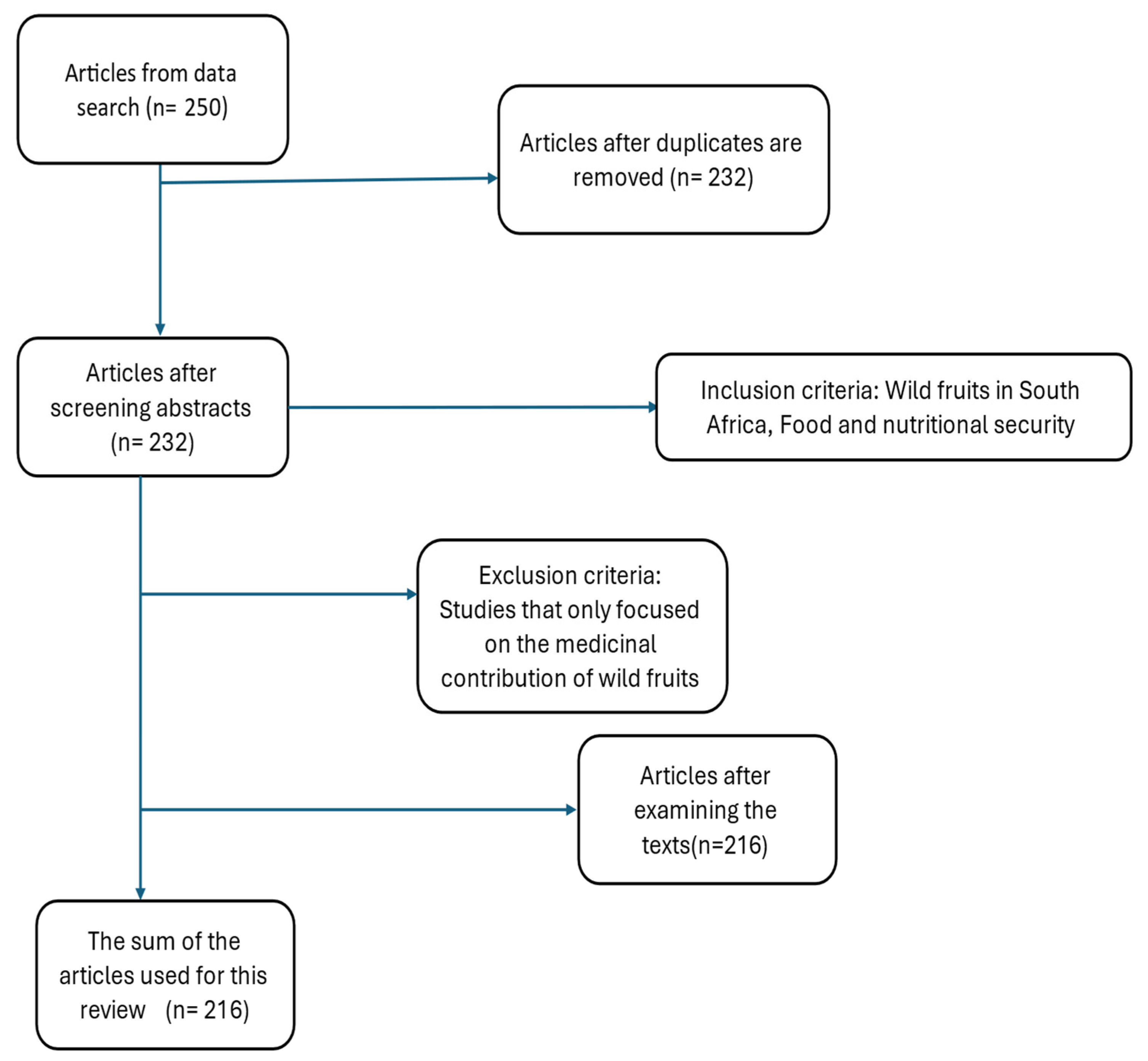
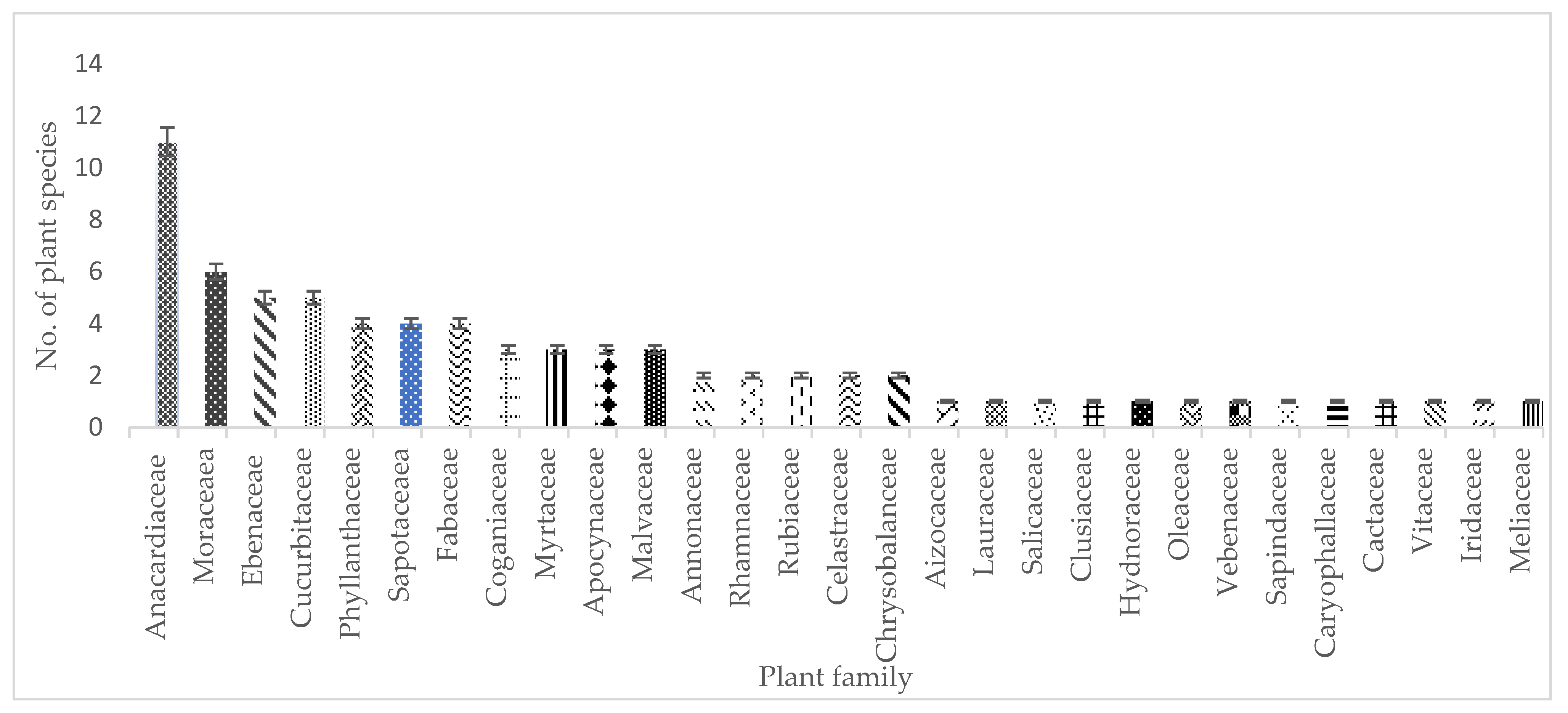
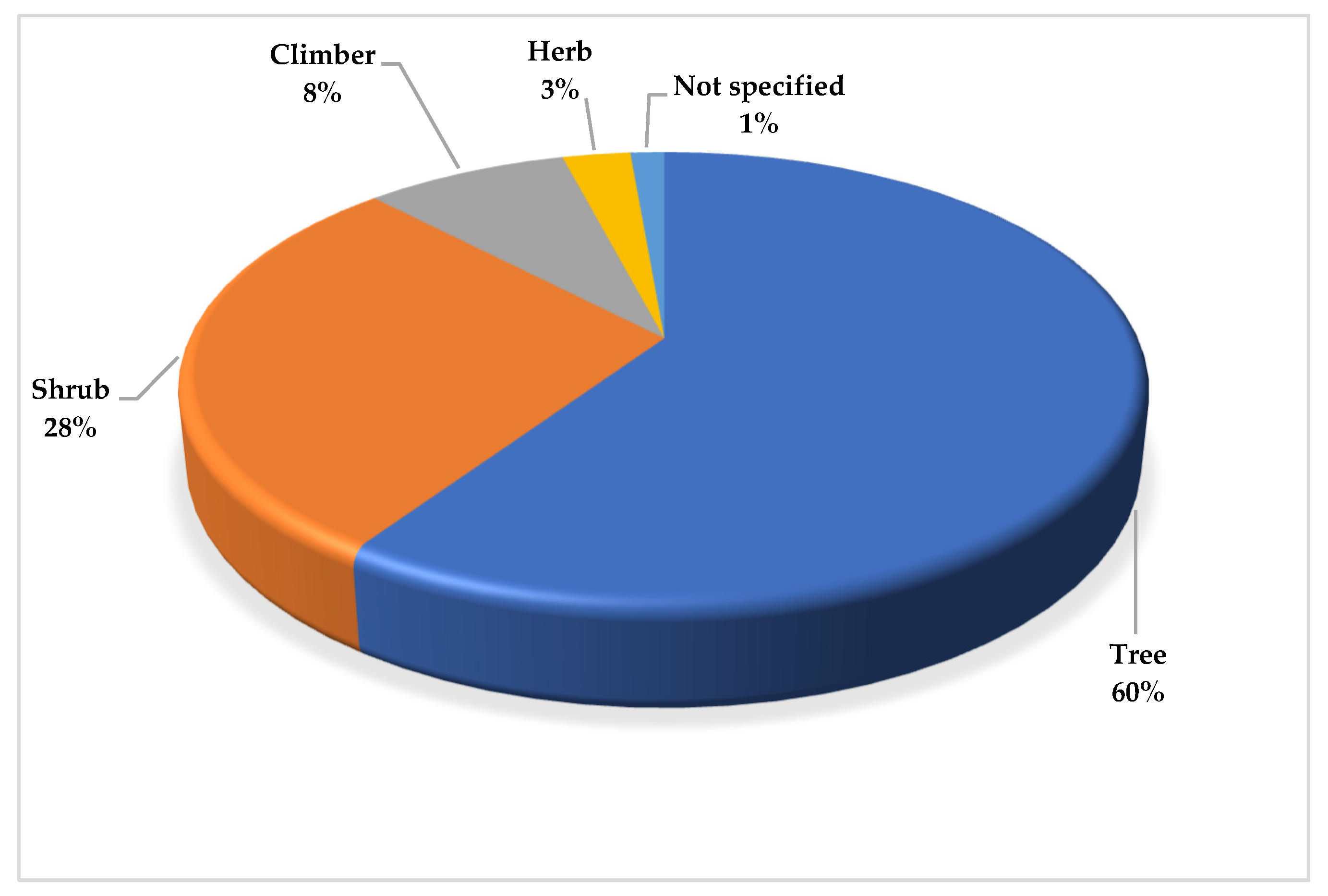
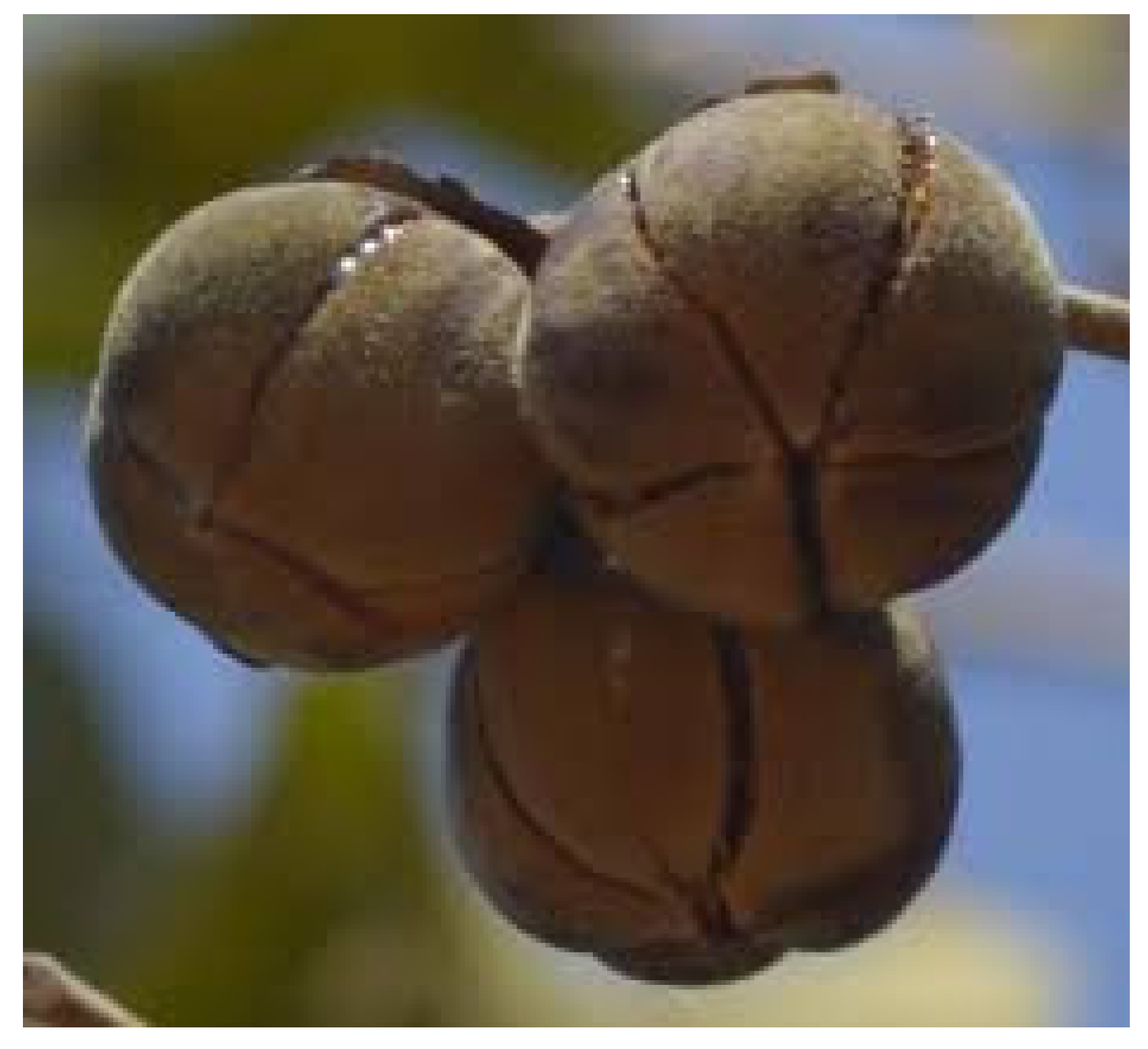
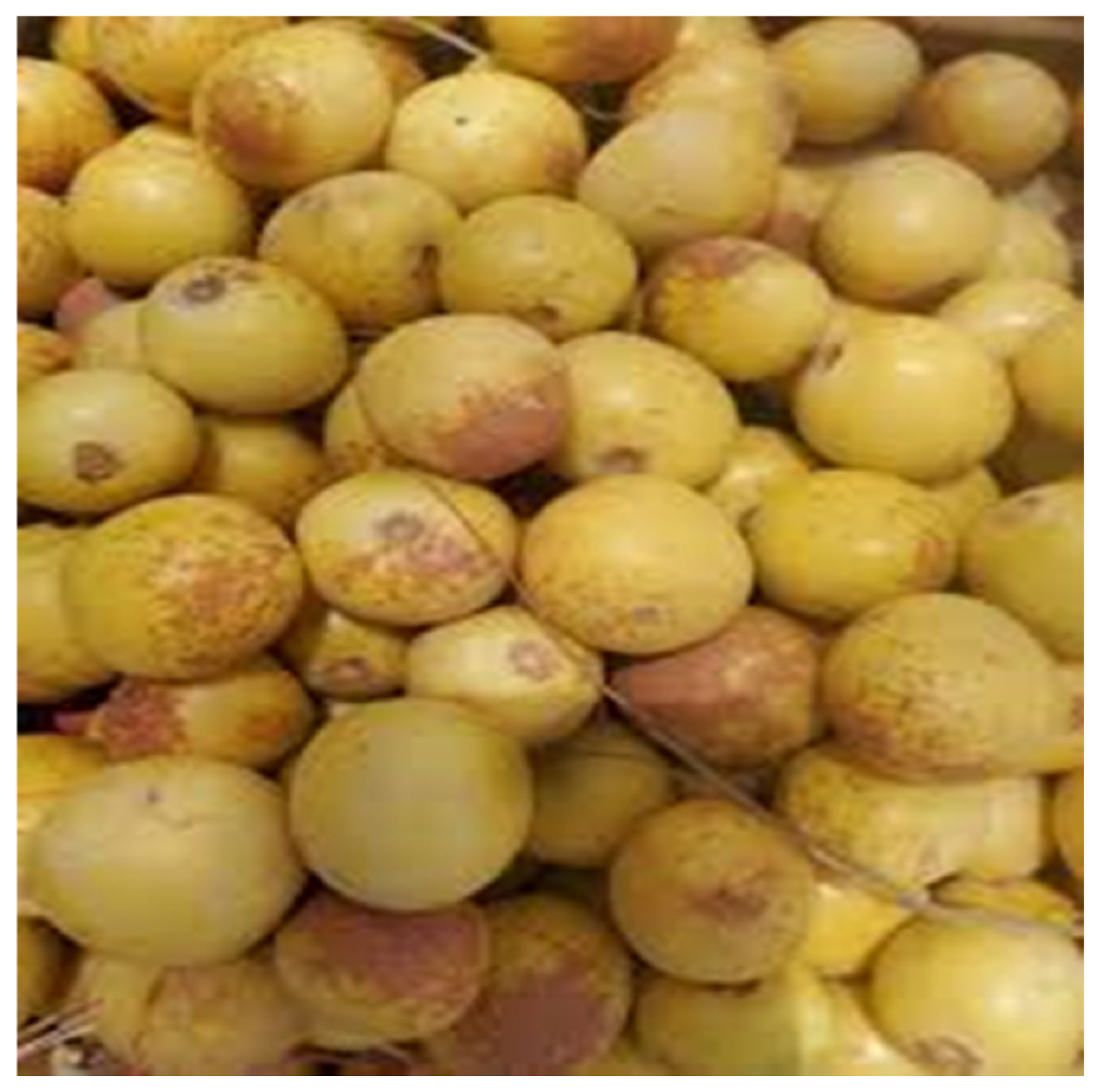
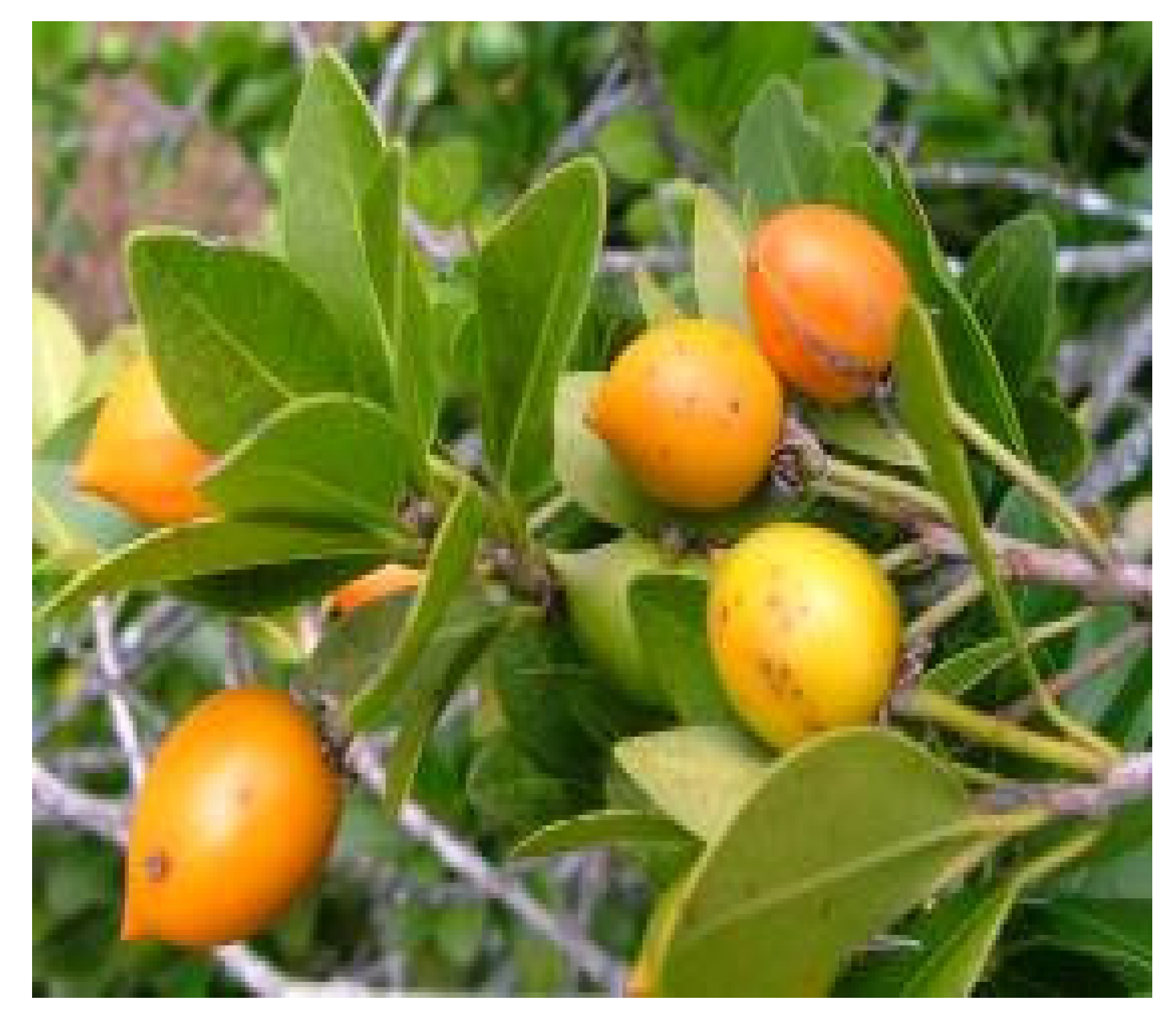
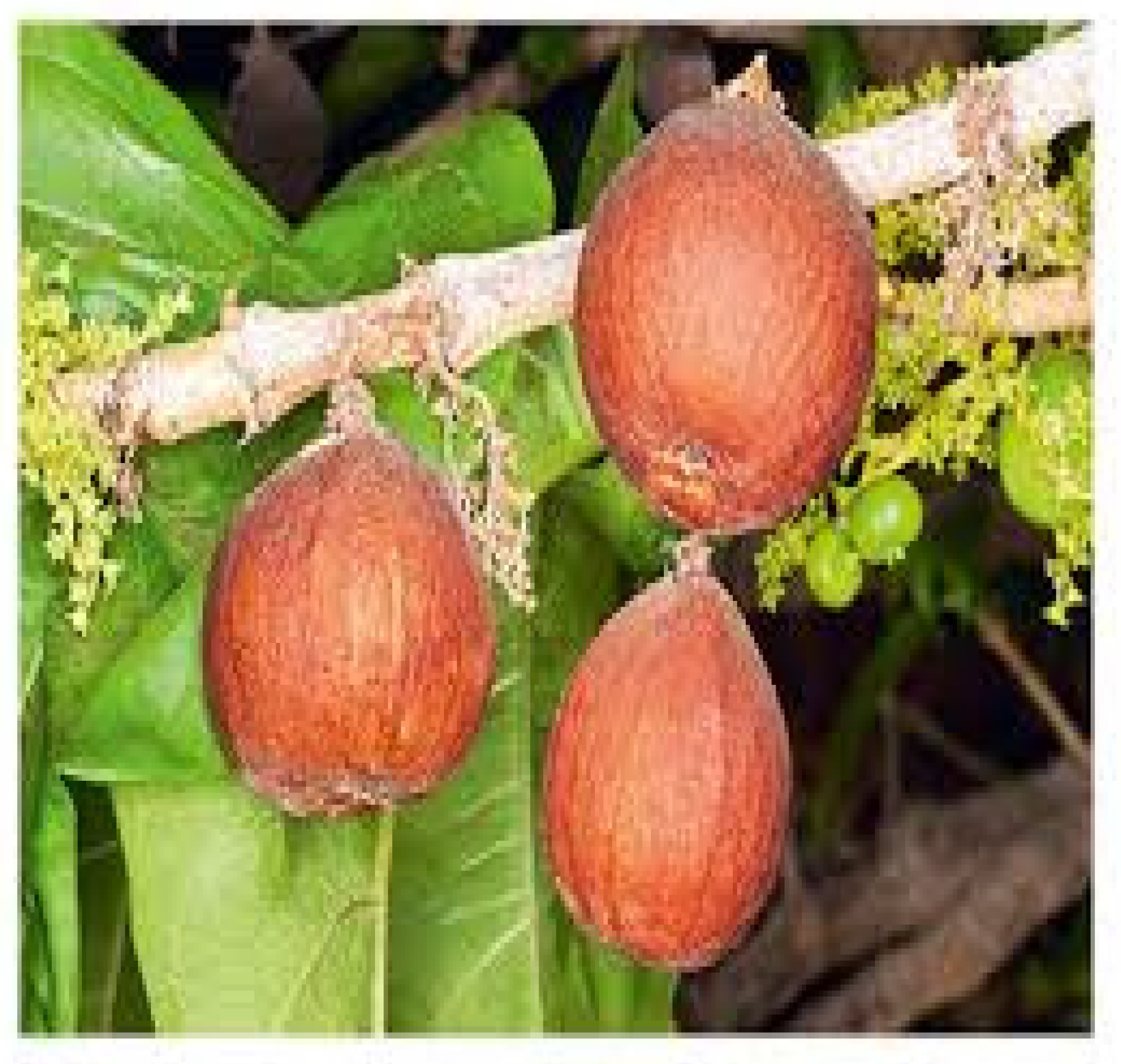
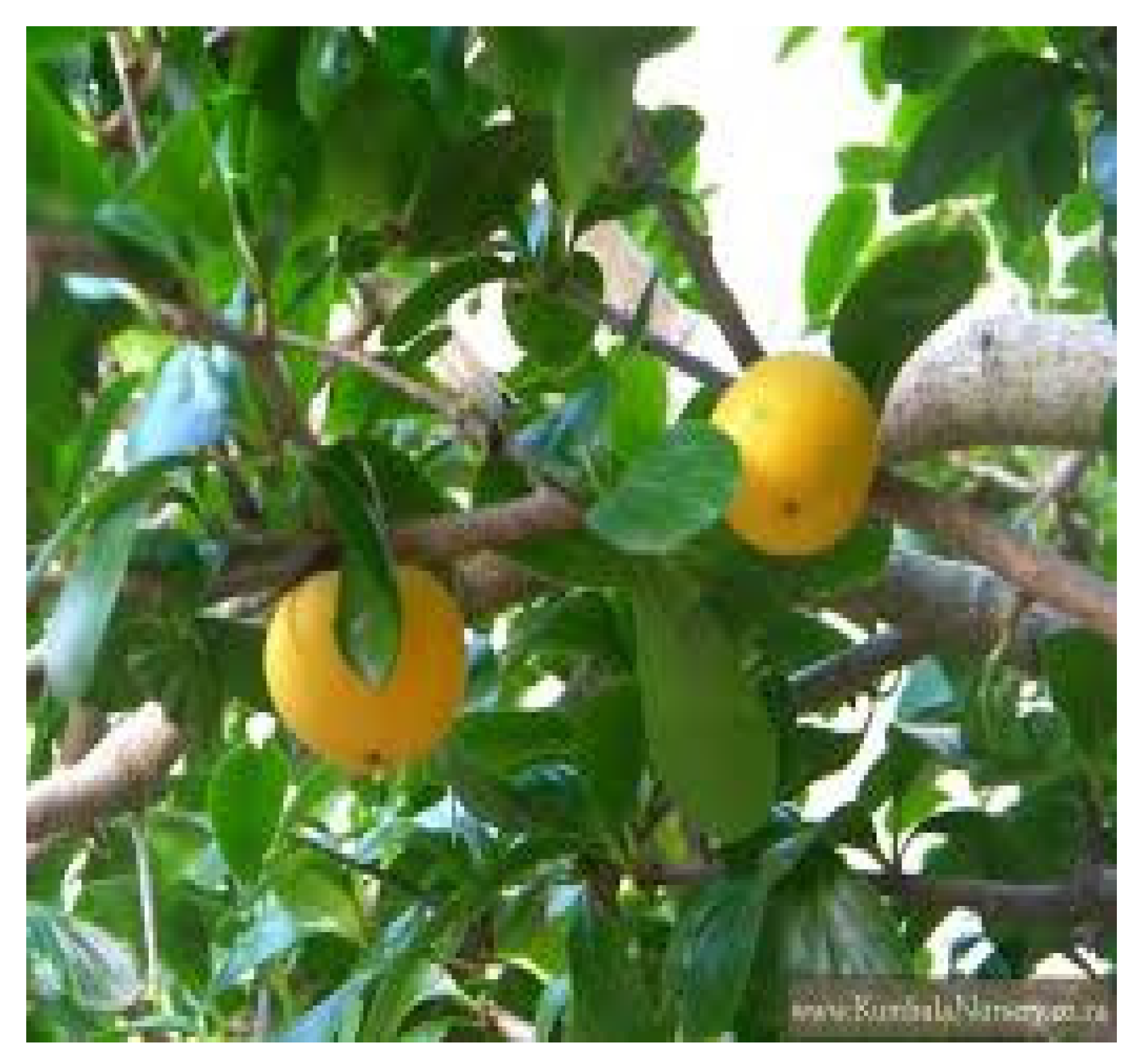
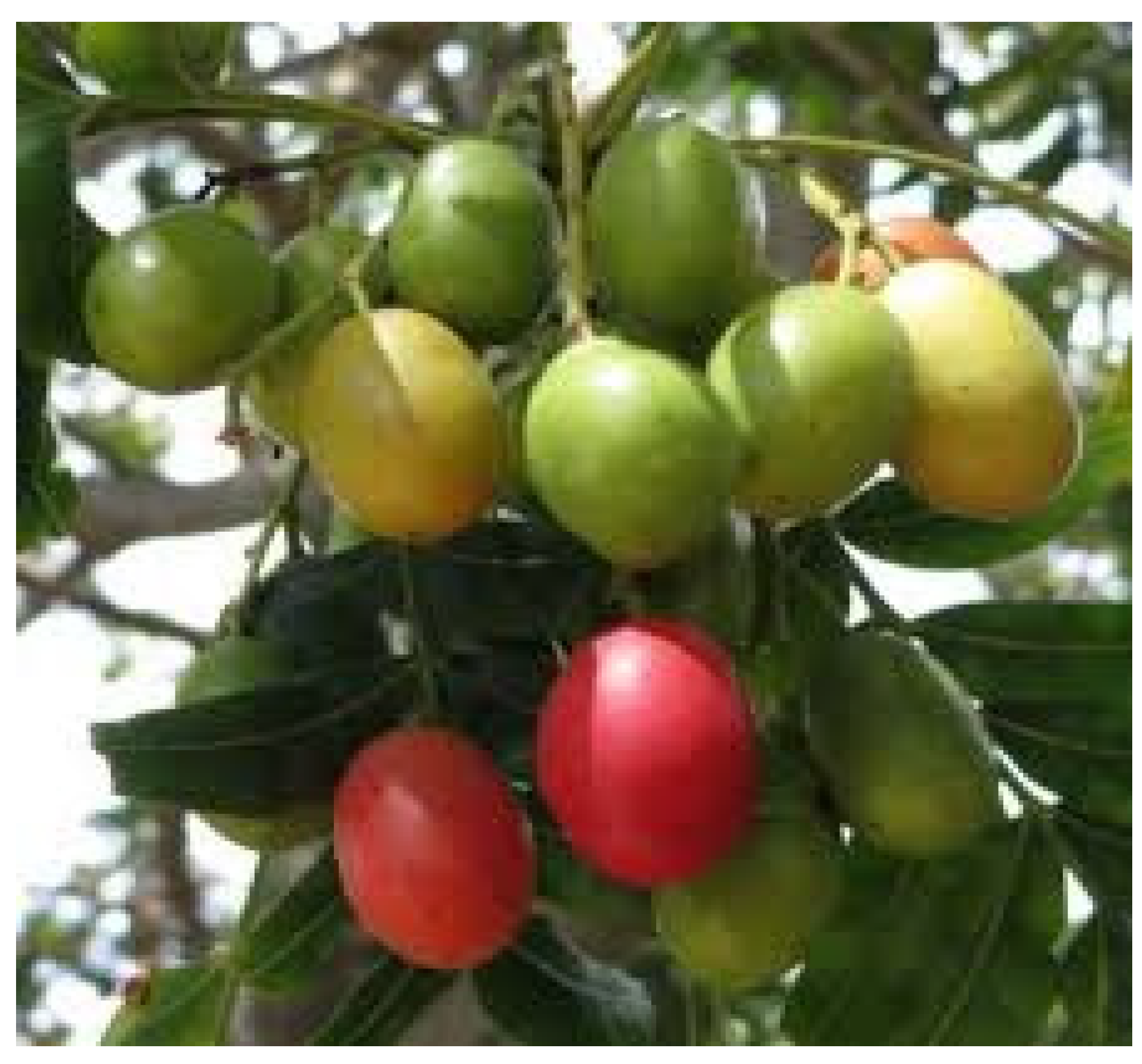
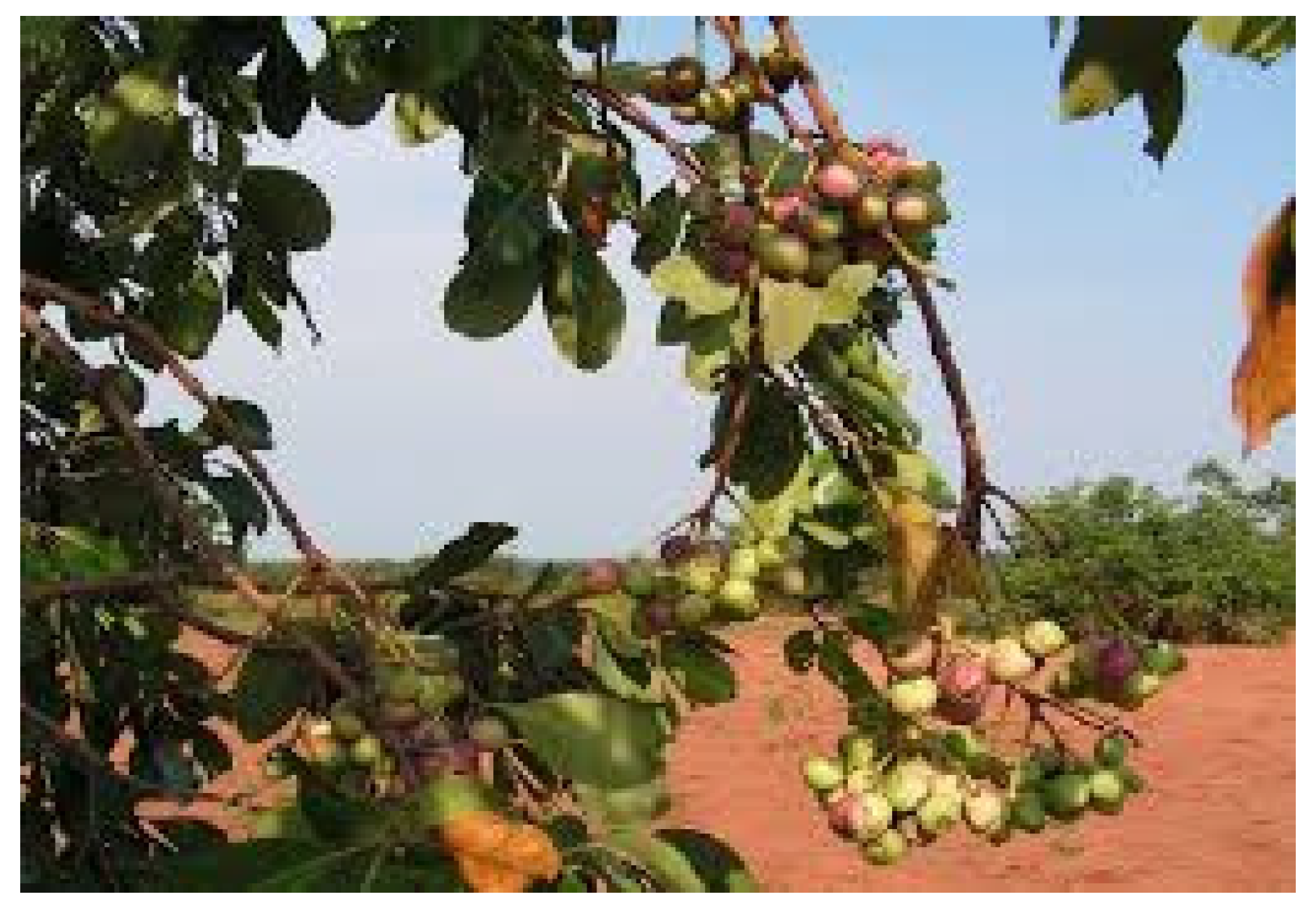
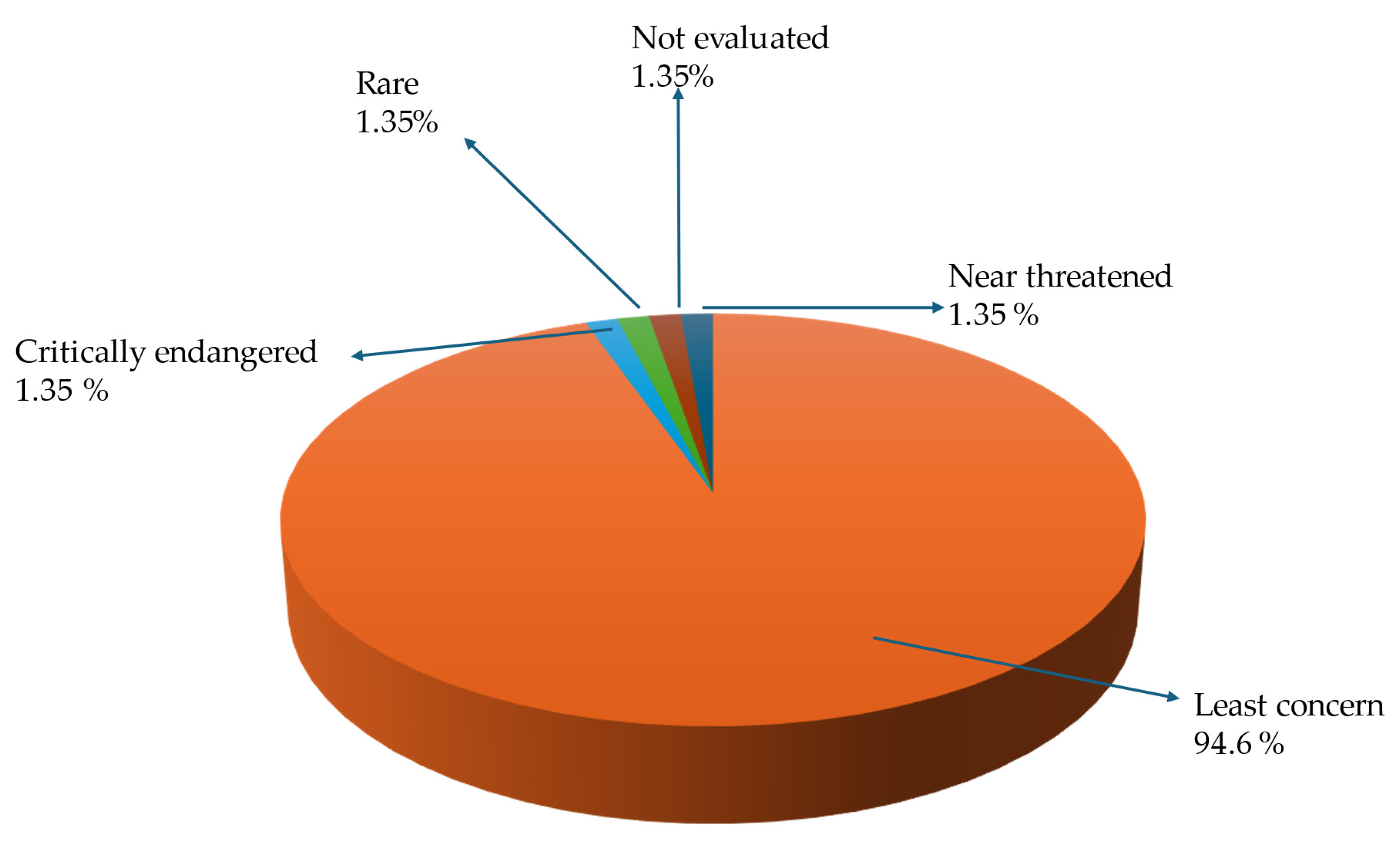
Disclaimer/Publisher’s Note: The statements, opinions and data contained in all publications are solely those of the individual author(s) and contributor(s) and not of MDPI and/or the editor(s). MDPI and/or the editor(s) disclaim responsibility for any injury to people or property resulting from any ideas, methods, instructions or products referred to in the content. |
© 2025 by the authors. Licensee MDPI, Basel, Switzerland. This article is an open access article distributed under the terms and conditions of the Creative Commons Attribution (CC BY) license (https://creativecommons.org/licenses/by/4.0/).
Share and Cite
Lubisi, N.P.; Matlala, M.E.; Ramarumo, L.J.; Ndhlovu, P.T. Ethnobotanical and Nutritional Evaluation of Understudied Wild Edible Fruits in South Africa: Bridging Indigenous Knowledge and Food Security: A Review. Foods 2025, 14, 1726. https://doi.org/10.3390/foods14101726
Lubisi NP, Matlala ME, Ramarumo LJ, Ndhlovu PT. Ethnobotanical and Nutritional Evaluation of Understudied Wild Edible Fruits in South Africa: Bridging Indigenous Knowledge and Food Security: A Review. Foods. 2025; 14(10):1726. https://doi.org/10.3390/foods14101726
Chicago/Turabian StyleLubisi, Nonhlanhla Preduence, Maropeng Erica Matlala, Luambo Jeffrey Ramarumo, and Peter Tshepiso Ndhlovu. 2025. "Ethnobotanical and Nutritional Evaluation of Understudied Wild Edible Fruits in South Africa: Bridging Indigenous Knowledge and Food Security: A Review" Foods 14, no. 10: 1726. https://doi.org/10.3390/foods14101726
APA StyleLubisi, N. P., Matlala, M. E., Ramarumo, L. J., & Ndhlovu, P. T. (2025). Ethnobotanical and Nutritional Evaluation of Understudied Wild Edible Fruits in South Africa: Bridging Indigenous Knowledge and Food Security: A Review. Foods, 14(10), 1726. https://doi.org/10.3390/foods14101726







